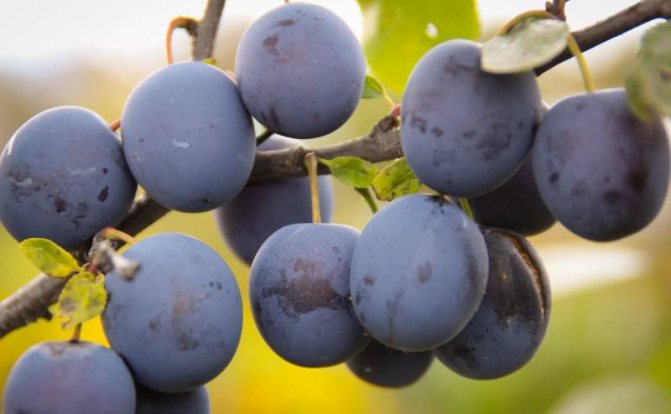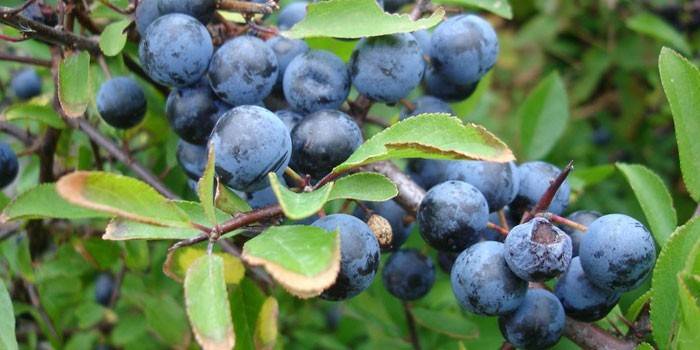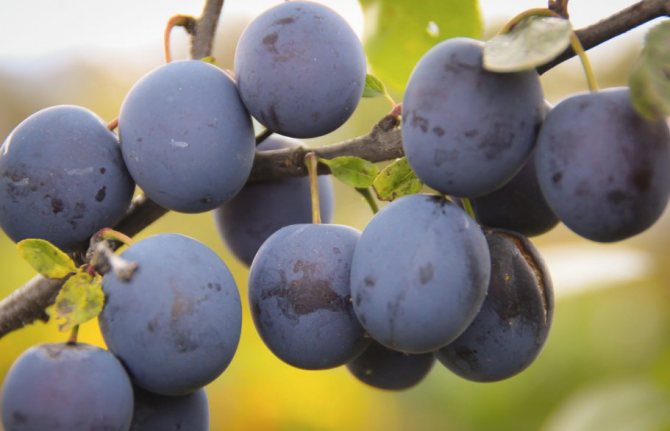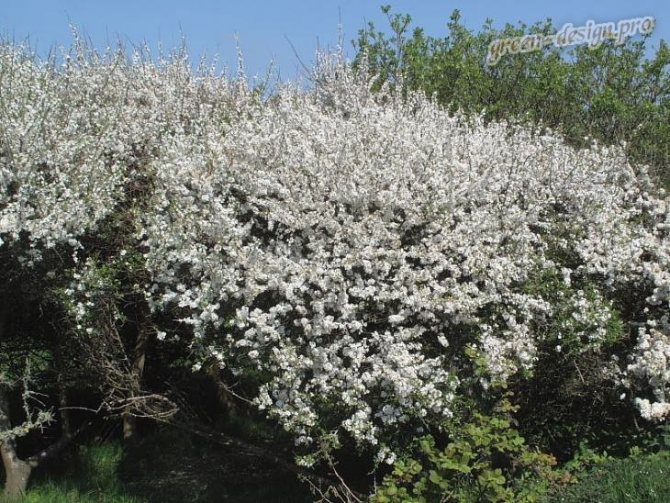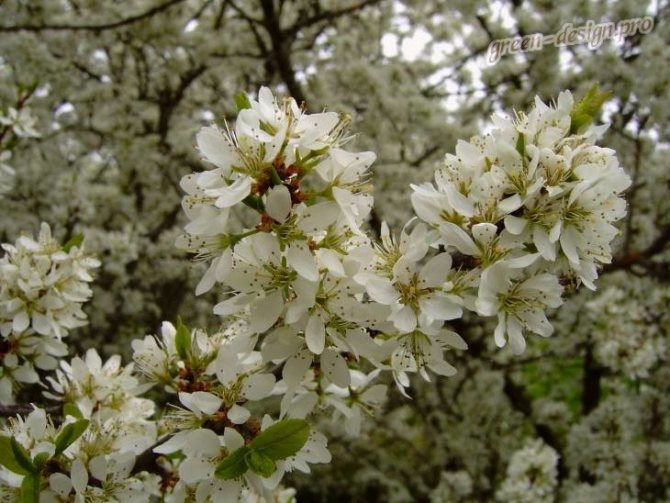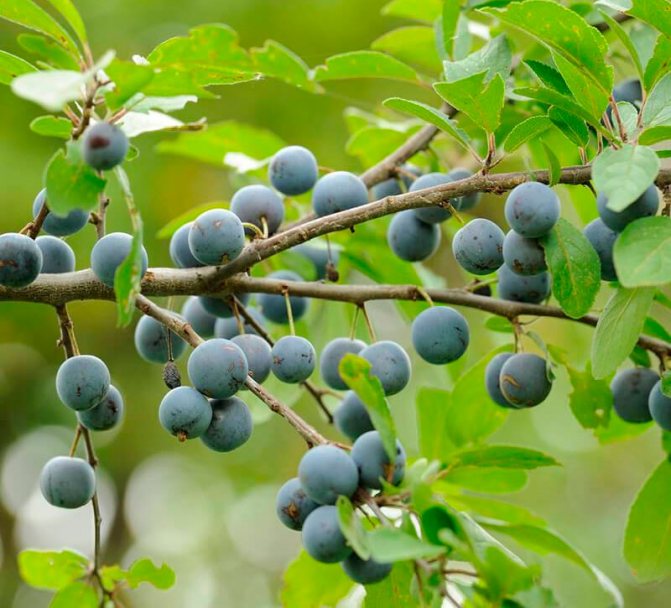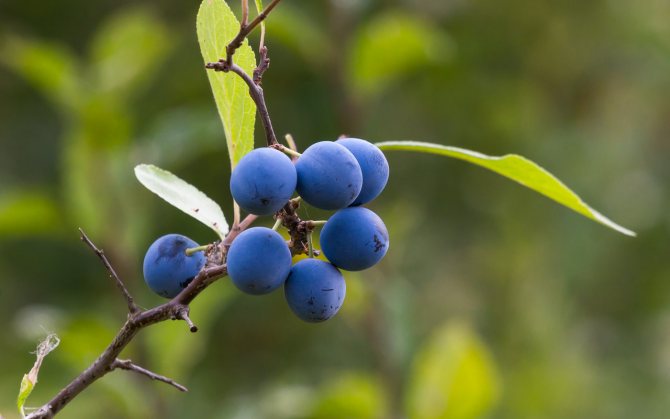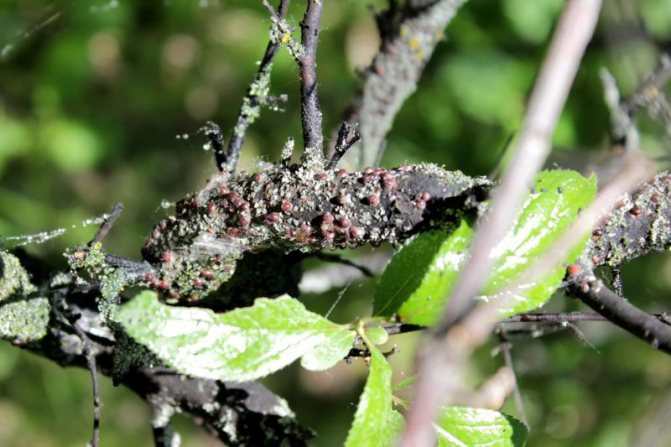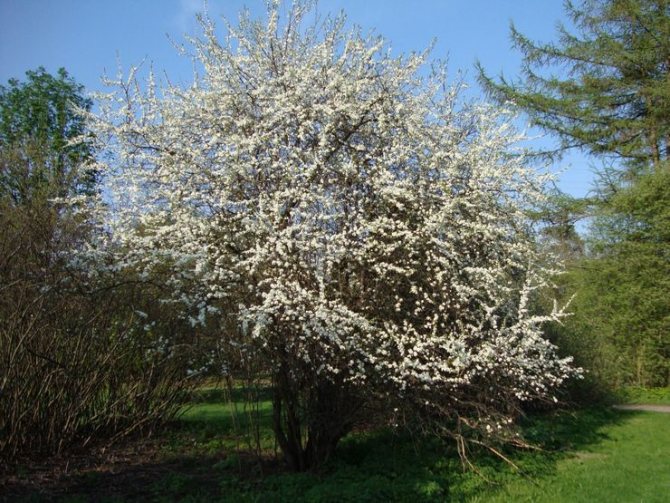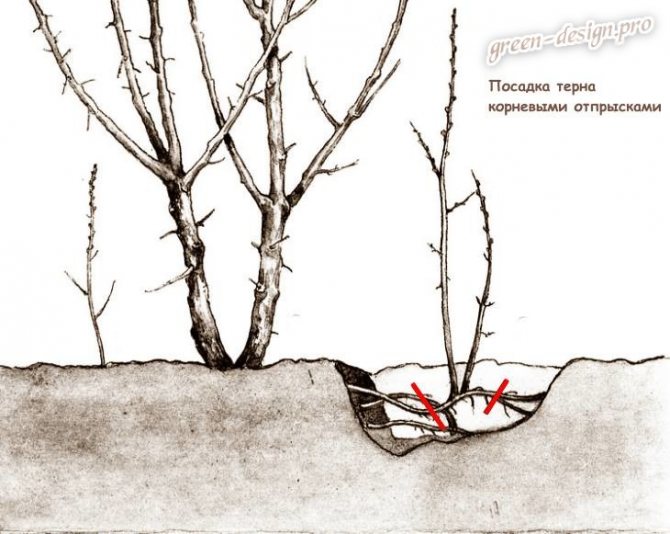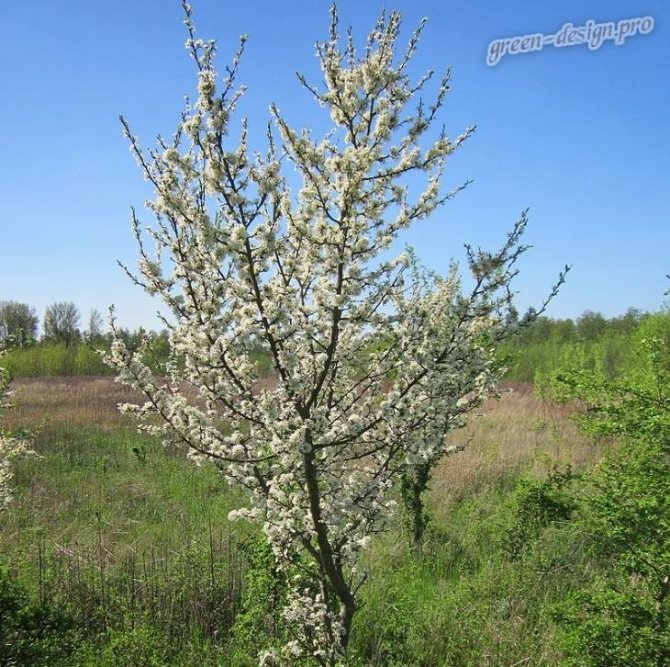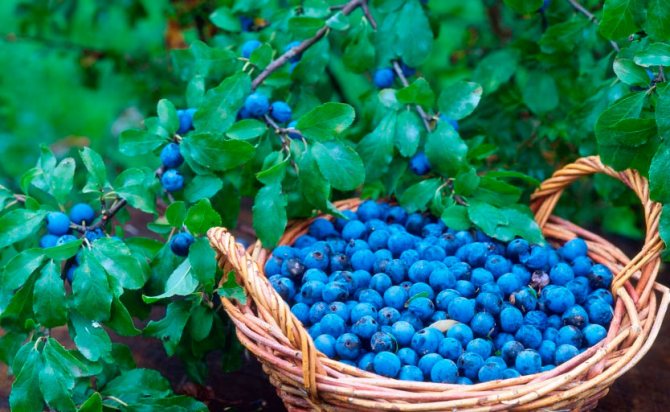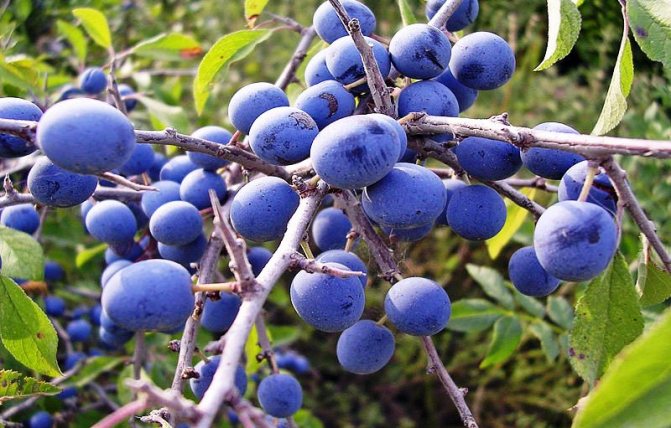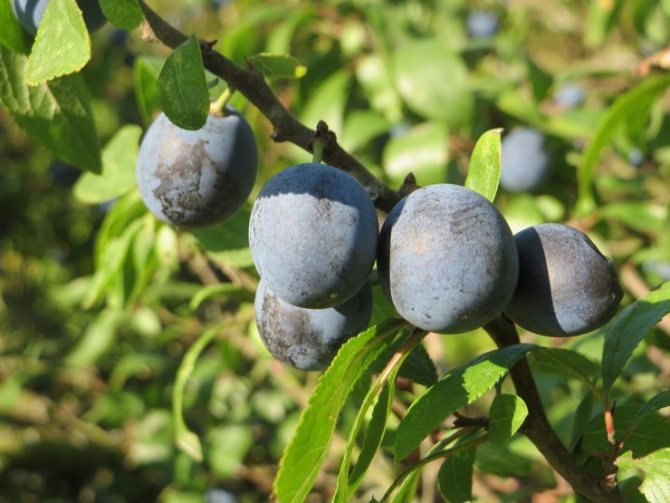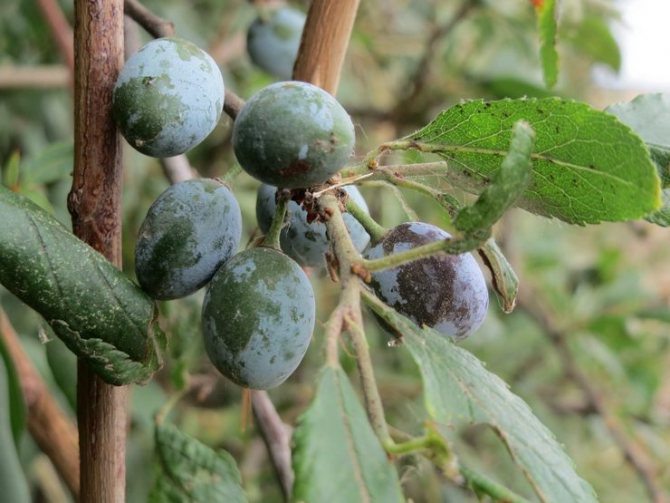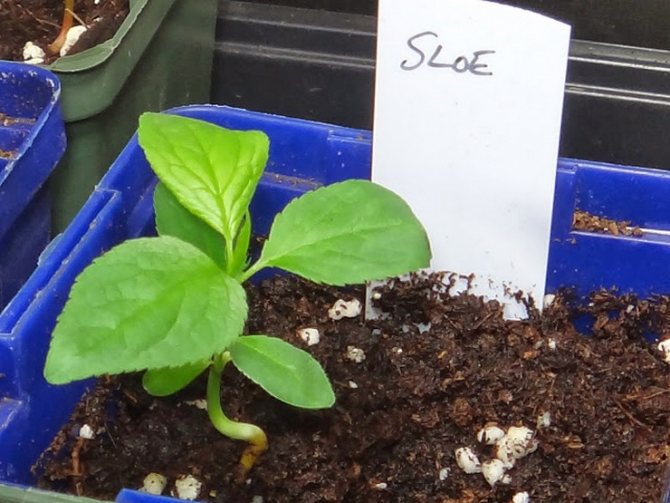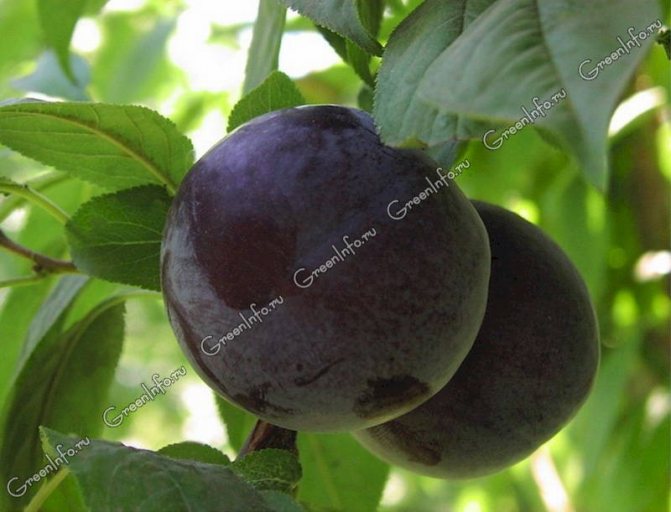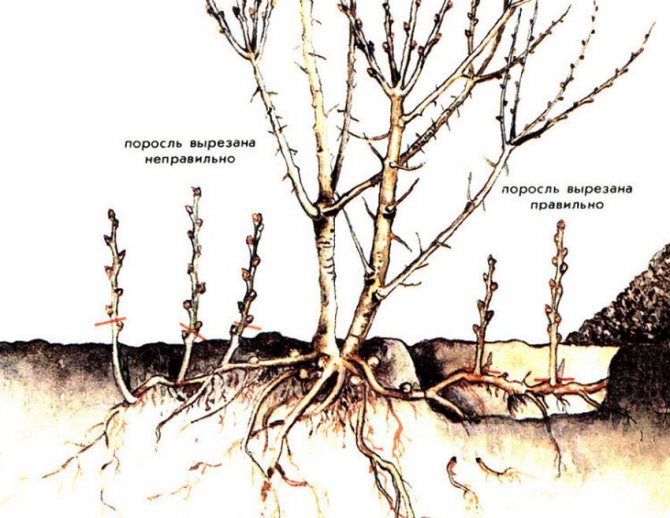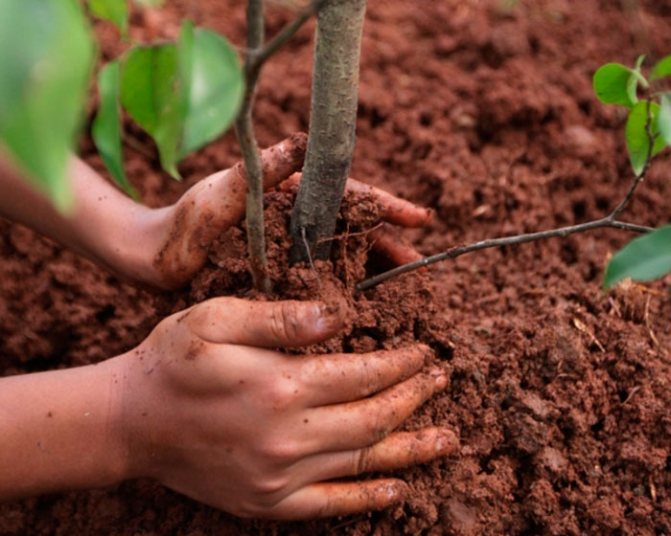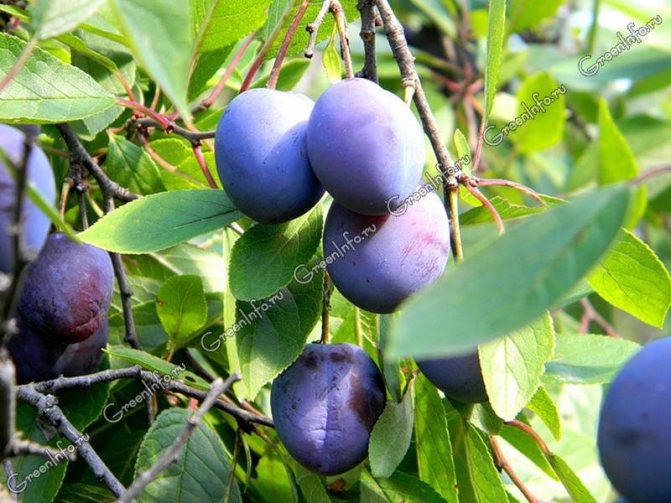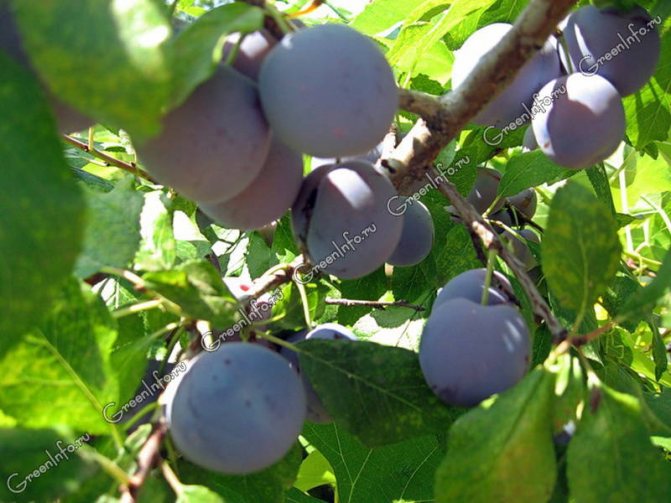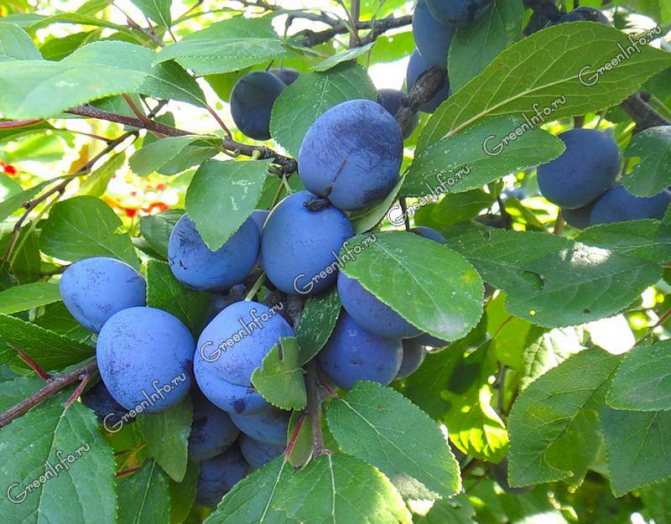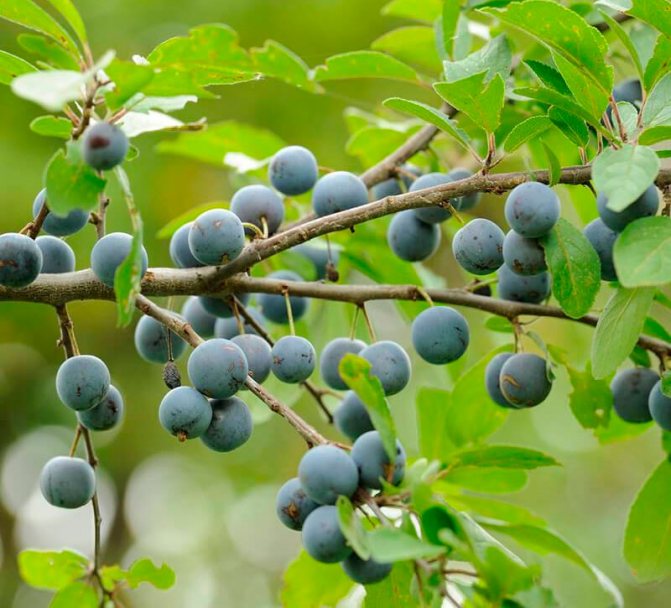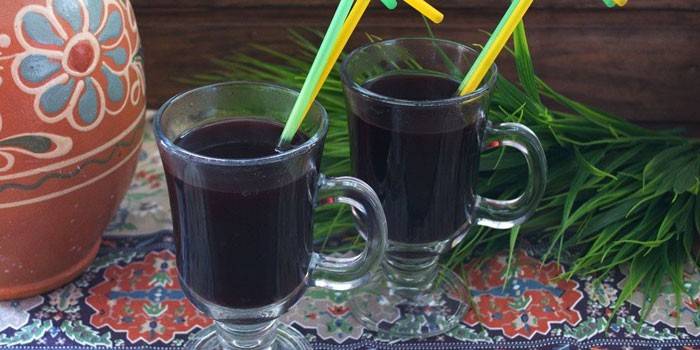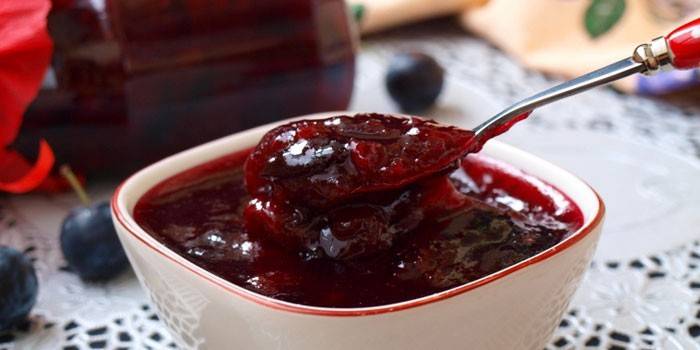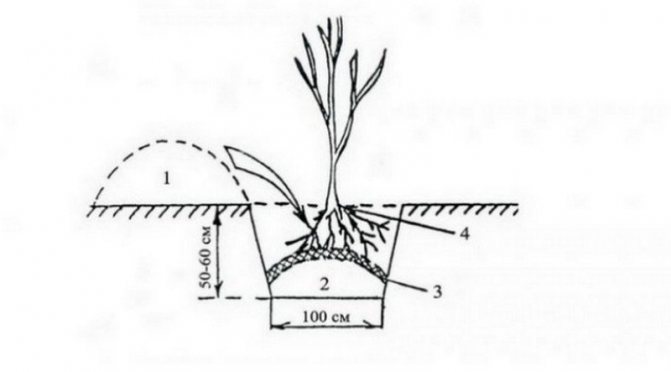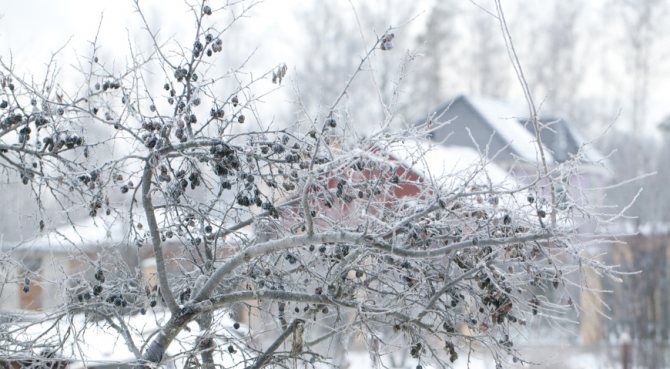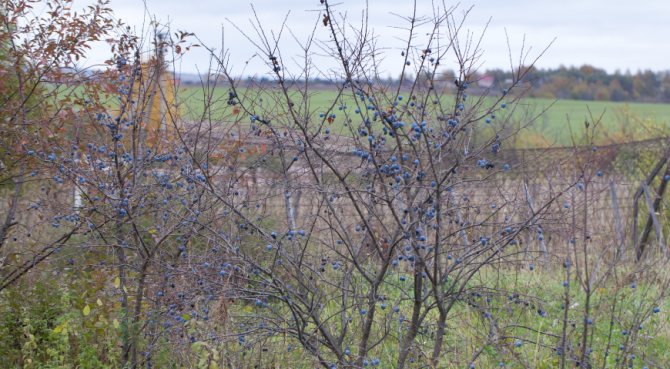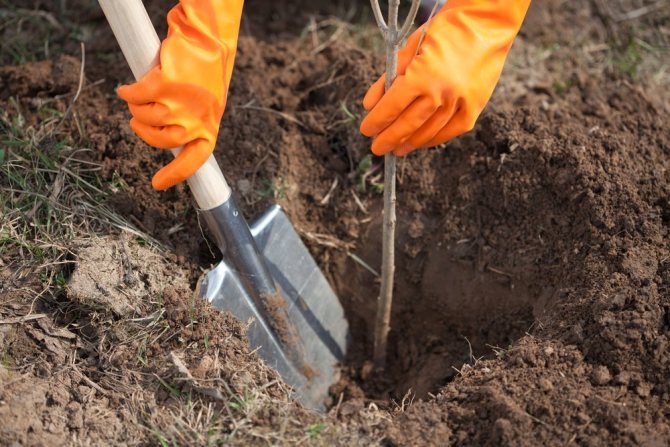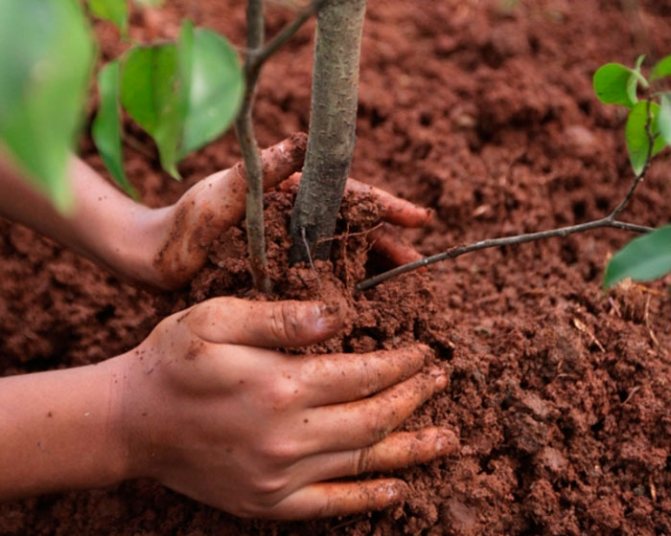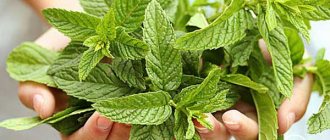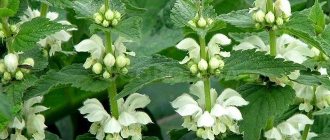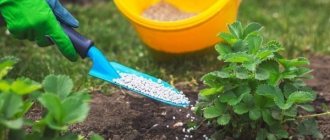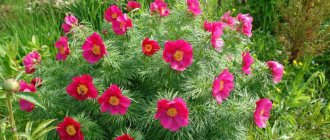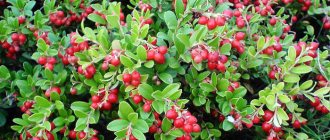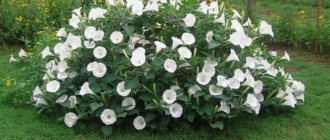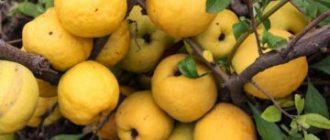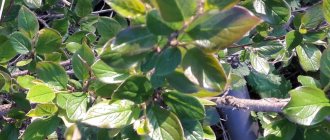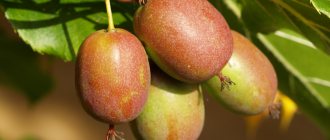Ternoslum or blackthorn plum is a fruit tree obtained by crossing plum and blackthorn. From a wild bush, the hybrid borrowed the endurance and useful qualities of the fruit.

blackthorn plum (Pninus insititia) is currently considered a subspecies of domestic plum
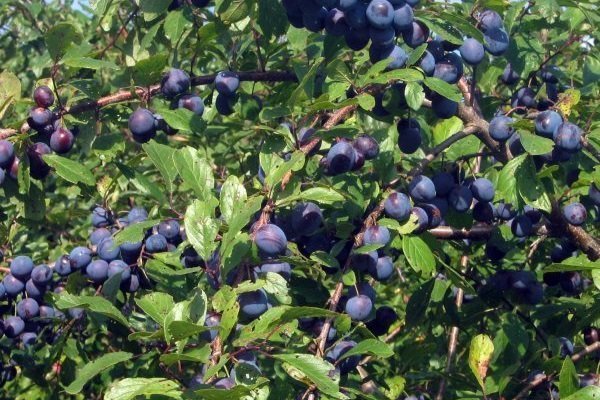

Thorny bush
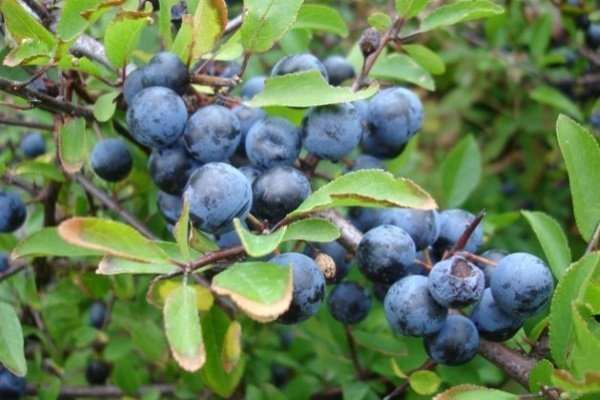

Ternoslum is a large shrub, often prickly
Gallery: blackthorn (25 photos)
Botanical illustration from the book by O. V. Tome "
Flora von Deutschland, Österreich und der Schweiz
», 1885
Unripe berries of steppe blackthorn
High, up to 5 m, shrub that forms dense thickets due to growth with the help of root (rhizome) offspring; less often a tree with a broad-ovate or spherical crown. Ribbed yellow-brown or purple young shoots are velvety pubescent at first, and then become naked, shiny. The shortened shoots are grayish, ending in a thorn.
The bark on the trunks is dark gray, slightly cracking. Oblong oval leaves are dark green, matte, leathery, 2-6 cm long, 1-3 cm wide, obtuse at the apex, with a wedge-shaped base, acute or crenate, sometimes double-serrate, in youth coarsely hairy, then mostly glabrous. In autumn, the leaves become partially bronze in color.
Flowers are single, rarely two, 1-1.8 cm in diameter; petals are white, oblong ovate.
The fruit is a drupe, black-blue with a bluish bloom, spherical or elongated-spherical, 10-15 mm in diameter. The pulp is greenish, tart, sweet and sour, poorly separated from the stone. The stone is light brown, spherical or ovoid, slightly flattened, pointed at the apex, lumpy-wrinkled.
Blackthorn (thorn) is a thorny branching shrub that reaches 3-5 m in height.It can rarely be seen as a tree up to 10 m high.
A distinctive characteristic of the plant is its increased root-forming ability. After a couple of years of development, difficult-to-pass thickets appear from multiple root suckers. The main habitat of the plant is forest edges, ravines and hillsides of the Caucasus, Central Asia, Western Europe and Siberia, the Mediterranean.
There is an opinion that the thorny bush originated from cherry plum due to the modification of plant tissues under the influence of gradual changes in the microclimate. Sloe is characterized by increased frost resistance and can withstand temperatures down to minus 40C. The plant can survive drought without much stress.
Thorns bloom profusely in April-May before the leaves open. The flowers of the shrub are white, small and are on short peduncles singly or in pairs. At this time, the plant resembles a large white ball, and the area around it is filled with the scent of almonds. The thorn begins to bear fruit a few years after planting.
The fruit is a monostyanka berry, with a small diameter up to 20 mm and a round shape. Under the black-blue thin peel there is a green pulp and a stone that cannot be separated from it. The berries ripen in August and last all winter. The fruits of the plant have a sour and tart taste: this is due to the increased content of tannins, which are neutralized after exposure to sub-zero temperatures.
Blackthorn is a self-sterile shrub and cannot set fruit from its pollen.In order for the berries to ripen, the shrub will need cross-pollination. As a rule, it is performed by bees.
The thorn shrub reaches a height of 3.5-4.5 m, and the thorn tree grows up to 8 m. The shrub expands in breadth due to root growth, creating thorny, difficult-to-pass thickets. The pivotal root of the blackthorn goes 1 m deep, and its root system is branched and protrudes far beyond the projection of the crown. The thorn branches are covered with numerous thorns, its leaves are up to 5 cm long, elliptical, dentate, obovate.
Thorns bear fruit from two to three years of age. The plant is distinguished by drought resistance and winter hardiness, in addition, it is a good honey plant. Planting and caring for thorns will not be difficult even for a novice gardener. Thorns are used as a rootstock for apricots and plums, they are planted as a hedge and to strengthen sliding slopes, and decorative varieties are grown to decorate the garden: red-leaved, terry and purple thorns.
Shrub 3.5-4.5 m in height, less often a low-growing tree no higher than 8 m. Growing and expanding with the help of root suckers, blackthorn forms dense thorny and difficult-to-pass thickets. The branches are abundantly covered with thorns.
Leaves are elliptical or obovate, toothed, up to 5 cm long.
The flowers are small, white, open singly or in pairs in early spring, when there are no leaves yet. Flowering is very abundant, in April-May, before leafing.
Flower formula: ∗ K (5) C5A20G1_ {displaystyle ast K _ {(5)}; C_ {5}; A_ {20}; G_ {underline {1}};} [4].
Fruits are rounded monochromatic plants, similar to plums, with a gray waxy coating, 12 mm in diameter, tart-sour to taste, ripen late.
It is a shrub that can grow up to 4 meters in height. Under some circumstances, the plant reaches great heights, so it looks like a tree. Its branches are very massive and they mainly grow in a horizontal direction. Most of the branches of the thorns are endowed with thorns, therefore it is often called the prickly plum or black thorn among the people.
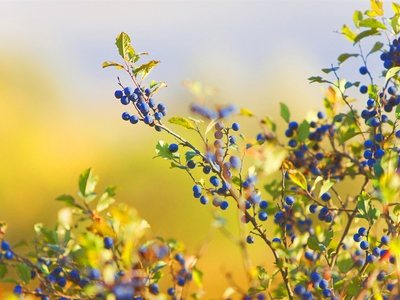

Teren is distinguished by its high resistance to any environmental conditions. He, unlike his fellows, is not afraid of even the most severe frosts.
The blackthorn leaves are oval and have a bright green color, and the fruits are round small blue berries.
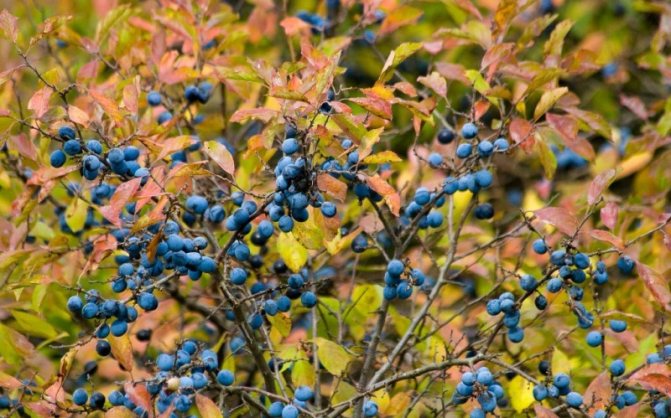

It is customary for many to plant this plant near the house or hang a twig over the door in order to scare away evil spirits.
As for the fruits, the berries of this unusual but healthy plant are very sour in taste and have some unusual viscosity. That is why this fruitful shrub is not among the ranks of berries preferred by people. However, the "unloved" taste and aroma of blackthorns are compensated by its invaluable and enormous benefits for the human body.
The main places where you can most often meet blackthorns are the western regions of Siberia, Ukraine, Moldova, the Caucasus. Ideal growing conditions for blackthorns are found on dry rocky areas, forest edges, ravines or the edges of field roads. The shrub is found even in some European countries, Iran, North Africa and Asia Minor.
What is the peculiarity of thorny?
Ternoslum appeared not through the efforts of breeders, but as a result of natural crossing. And only then, having appreciated the advantages of the hybrid, people began to breed new varieties of it. Ternovka, like the blackthorn, belongs to the Pink family, to the genus of plums.
Previously, blackthorn was considered a variety of blackthorn. It was called dessert thorns or sweet thorns. The botanical description of this plant is very similar to the blackthorn:
- Appearance. Thorny branching shrub up to 4 m high. Leaves are small in size - 4-5 cm, oblong-elliptical, with serrate edges.
- Bloom. It blooms profusely. The flowers are snow-white, single, 2-3 cm in diameter. They bloom earlier than the leaves.
- Fruit. Globular, dark blue or black, with a waxy coating. The dense pulp has a sweet and sour tart taste. Fruit weight - 15 g. Diameter - 4 cm. Inside - a stone.
Features of the thorny plum:
- Stably bears fruit abundantly. The fruits ripen in August-September. When ripe, they do not fall off - they hold tightly to the branches until winter.
- Withstands frosts down to minus 40 ° С. This is one of the most frost-resistant fruit crops.
- It grows excellently in harsh climatic conditions and in unfavorable terrain. Can grow in the poorest soils.
- Disease immunity. Not affected by pests.
- High endurance. Resistant to droughts, quick recovery of frozen roots, the bark is not affected by the sun.
The longer the fruits of thorny plums hang on the branches, the sweeter they become, and the less astringency they have.
Ternovka endures any cataclysms and difficulties, the only thing she avoids is salty boggy soils. This plant gives numerous shoots, so it is not recommended to plant valuable crops near it.
Spread
The northern border runs north of 60 ° N. on the Scandinavian Peninsula and in the extreme south-west of Finland, then goes through the extreme west of Estonia, western and southern Latvia. In Russia through the Pskov, Smolensk, Moscow, Vladimir regions, Mordovia, the southern part of Tatarstan. Kazakhstan, Western Europe, Tunisia, Asia Minor, Iran.
It usually grows in dense thickets, mainly in the forest-steppe and in the outcrops of shrubs in the steppe, often along the edges of the forest, in felling areas. In the Crimea and the Caucasus, it occurs up to heights of 1200-1600 meters above sea level [3].
Found in the forests of Western Europe, North Africa and Asia Minor. Grows in the forest-steppe and steppe regions of the European part of Russia, in the mountains of the Crimea and the Caucasus, rising to 1200-1600 m above sea level.
Common in all natural and administrative regions of the Saratov Right Bank. In the Rtishchevsky district, it was noted in forest plantations along the Shuklino railway - 106 km.
Distribution area and climatic features
The homeland of thorny plums is Southwest Asia. The hybrid first appeared in Syria. Here he was known as the "Damascus Plum". Then the blackthorn was brought to England, from where it spread throughout the countries of Europe.
The tree, possessing unique frost resistance and drought resistance, is capable of growing in the most extreme conditions. Today, the hybrid is ubiquitous, and as a fruit tree it is grown in Europe, India, North America, Western Asia, and North Africa.
Plant care
It should be borne in mind that all the beneficial properties of a wild shrub can evaporate if its fruits or berries were not picked quite correctly and at the wrong time. It all depends on how the harvested fruits, roots or flowers were harvested.
If we talk about harvesting blackthorn flowers, then it is best to start this process during the maximum flowering of the plant. For drying, it is preferable to choose well-ventilated rooms, but for storage - darkened places. As for the container itself, where the harvested product will be stored, it should be glass or tin dishes with a tight-fitting lid.
Thorn leaves are collected somewhere in the middle of summer, and this should be done after the shrub has completely bloomed. Drying and storage conditions for leaves are exactly the same as for flowers.
A good time to harvest thorn bark is in the spring before the plant begins to bloom. The collected bark is first dried outside, and then it can be dried in the oven as well.
The collection of young shoots and branches takes place in May-June. To dry them, they are placed in a dark and well-ventilated area.For preservation, shoots and branches are collected in bundles, only they can be stored for no more than one year.
Blackthorn berries are harvested and harvested in early fall. But it will be better if you start doing this after the first frost.
A distinctive feature of the blackthorn is its unpretentiousness to growing conditions. Constant feeding of the bush and excessive care, on the contrary, begin to lead to abundant development and suppression of nearby plants. This can be prevented if, when planting, the roots of the thorn are protected from horizontal spread with a sheet of iron or slate.
For planting thorns, it is best to choose a partial shade or well-lit area. The land must be with neutral acidity and drained moisture-absorbing soil. The optimal distance between plants is not less than 2 m. At the beginning of spring, rejuvenating pruning is performed, removing rotten and damaged branches.
Water the plant only in very dry weather. For the formation of new shoots during flowering and improving the quality of fruits, organic matter is added to the near-stem circle: rotted manure or compost. Blackthorns do not need shelter in winter.
Agrotechnical measures
Ternoslum is an unpretentious plant, caring for it is reduced to standard activities that require a minimum of time and effort. The blackthorn is taken care of in much the same way as the plum, but in a simplified version.
Soil care
The soil in the trunk circle is periodically loosened - for better penetration of moisture and oxygen. When loosening, you should not be too zealous, with deep processing you can damage the roots - the plant can get sick and even die.
Is feeding required?
Ternosplum gives its first harvest in the 3rd or 4th year. From that moment on, they begin to feed her. Fertilizers are applied in the fall - at the end of October, during the digging of the soil, per 1 sq. m:
- manure - 5 kg;
- superphosphate - 50 g;
- potassium sulfate - 20 g.
Before applying fertilizers, weeds are removed from the soil and carefully dug up. After fertilizing and re-digging, the soil is mulched with straw, sawdust, fallen leaves.
Fertilizers can also be applied in the spring and summer season. It is recommended to feed the plant:
- In early spring. Nitroammophos - a tablespoon per tree (can be dissolved in water).
- After flowering. Superphosphate and potassium sulfate - a teaspoon per 10 liters.
- After fruiting. Wood ash - 250 g.
Irrigation and their cyclicity
Water the thorny plum while it is young, like other fruit trees - 1-2 times a week. Depending on the weather. An adult tree is watered as needed. The plant is drought-resistant, and even if the gardener cannot water it once or twice, this will not particularly affect the condition of the tree or the harvest.
Tree pruning
Often, gardeners refuse to prune thorns. This leads to the growth of branchy shoots. The plant forms a sparse-tiered crown or makes it bushy.
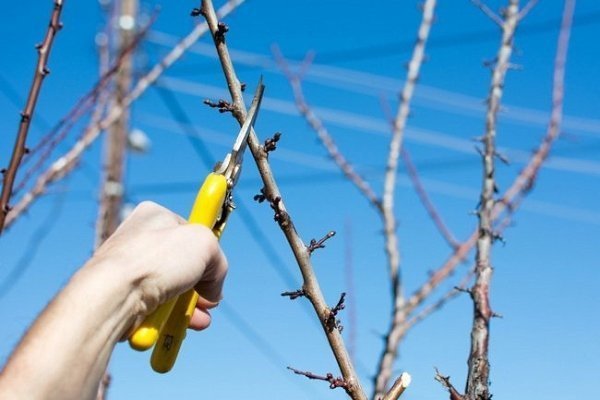

Pruning is the most time consuming activity in all the care of a thorn. During the season, the plant is pruned three times:
- in late March;
- at the end of June;
- at the end of July.
In order to preserve the given shape and maintain the yield of the tree, pruning is carried out:
- Sanitary. All damaged, diseased and dry branches are removed.
- Anti-aging. It is carried out with the aim of extending the life of the plant. Several fruiting branches are cut off, and after a year the remaining skeletal branches are shortened by a third.
- Thinning. With its help, thickening is prevented, which prevents the penetration of light to the fruits. If the plant is bushy, no more than 4-5 fruiting branches are left.
- Molding. This pruning is done if the plant is used as a hedge or to make the crown look attractive.
When the bushes grow old or freeze, powerful shoots help rejuvenate and restore the plant.
Wintering ternos
Ternoslum tolerates frosts so well that it does not need insulation. But from rodents who want to gnaw the bark in winter, protection is needed. So that hares and other bark lovers do not damage the tree, its trunk is wrapped with roofing material or barbed wire.
If it happens that the thorny plum still freezes, it quickly recovers - thanks to the stump shoots.
The chemical composition of blackthorn
The thorn plant is an amazing shrub with an incredible chemical composition that every person should be aware of. It turns out that blackthorn berries have a rather large amount of fiber, tannins, pectin, carbohydrates useful for humans. In addition, the prickly plum contains:
- Apple acid;
- ascorbic acid;
- vitamin C and P;
- nitrogen-containing compounds;
- carotene.
And 100 g of the product contains about 50 calories.
Differences between the turner and the thorny plum
Blackthorn is a shrub with healthy but tasteless fruits. Thanks to crossing with plum - the value of its tart fruit was "flavored" with plum sweetness. At the same time, practically all the useful qualities of the blackthorn fruit were passed on "by inheritance" to the hardy.
In the thorny plum, in contrast to the blackthorn, the fruits are much larger, sweeter and juicier, and most importantly, they are not so tart. The blackthorn is not as prickly as the blackthorn - it is much easier to harvest the fruits from it. The fruits of blackthorn and thorns have a similar chemical composition. The only major difference is the sugar content:
- on the turn - 5-6%;
- in thorny plums - 12-14%.
Properties of thorns - harm and benefit
Blackthorn berries contain sugars (fructose and glucose), malic acid, pectin, carbohydrates, steroids, fiber, triterpenoids, vitamins C and E, coumarins, nitrogen-containing compounds, tannins, flavonoids, higher alcohols, mineral salts, fatty acids linoleic, palmitic, stearic, oleic and eleostearic.
Fresh and processed thorn fruits have an astringent effect and are used for such disorders of the intestines and stomach as ulcerative colitis, dysentery, food poisoning, candidiasis and toxic infections. Blackthorn wine is also considered a medicinal drink for infectious diseases.
The fruits of blackthorn are used in the treatment of kidney and liver diseases, neuralgia, vitamin deficiencies, metabolic disorders, and also as an antipyretic and diaphoretic. Fruits and flowers are indicated for cystitis, edema, gastritis, kidney stones, pustular skin diseases and boils. Thorn flowers have a mild laxative effect, treat skin diseases dependent on metabolism, regulate the contraction of the renal ducts and intestinal motility, acting as a hypotensive, diaphoretic and diuretic, and in the form of a decoction are used for hypertension, shortness of breath, constipation, furunculosis and nausea.
Fresh juice of thorn berries, possessing antibacterial activity against protozoan parasites, is used for giardiasis and intestinal disorders.
A decoction of thorn flowers is prescribed for inflammation of the mucous membranes of the throat, esophagus and mouth, and tea from thorn leaves is a mild laxative and increases urine output. They drink it for cystitis, chronic constipation and prostate adenoma. It is recommended for people with a sedentary lifestyle.
In addition to the astringent, preparations from blackthorn have anti-inflammatory, diuretic, expectorant and antibacterial effects, relax the smooth muscles of internal organs, and reduce vascular permeability.
Because of the acidity in blackthorn fruits, they can harm people with stomach acid, gastritis, or ulcers. The intense color of the fruit can cause an allergic reaction. Thorns contain a strong poison, so be careful not to accidentally swallow them. It is not recommended to consume thorns for people with hypersensitivity to its fruits, and excessive consumption of thorn fruits is not beneficial even for healthy people.
Sections: Fruit and berry plantsBerry bushesFruit treesPlants on T
After this article, they usually read
The healing properties and contraindications of blackthorn are not known to everyone. This is understandable, because some have not even heard of such a plant, let alone talk about its healing properties.
The composition of this magical plant contains special substances that can have such actions as:
- anti-inflammatory;
- diuretic;
- laxative;
- cleansing;
- antipyretic.
In addition, blackthorn possesses such medicinal substances that contribute to the regulation of impaired kidney function. With the correct use of blackthorn fruits, you can achieve a quick establishment and normalization of the metabolic process in the body.
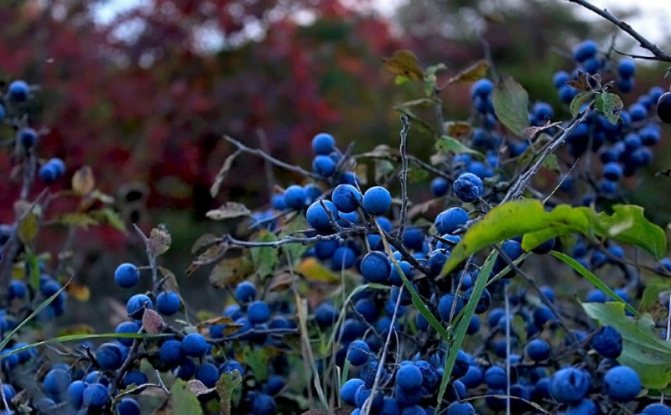

It should be borne in mind that all the useful properties of a wild shrub can evaporate if its fruits or berries were not collected quite correctly and at the wrong time.
Harvesting and storage rules for thorny plums
The signal for harvesting is a change in the appearance of the fruits - they are removed when the skin darkens to a color typical for the variety. The fruits collected from the tree are placed in two layers in small boxes - holding no more than 10 kg.
The timing of harvesting depends on the further purpose of the fruit:
- for fresh consumption or for processing - in the phase of technical ripeness;
- for transportation - before the onset of technical ripeness, as soon as the fruits become soft and begin to color.
Fresh thorny plums can be stored:
- in the refrigerator - 3 months;
- in a cool room - 1 month.
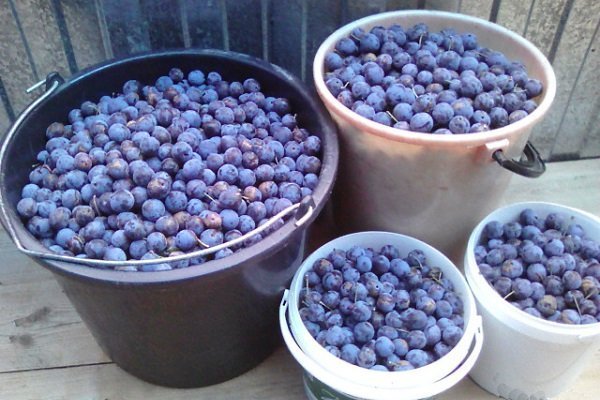

Economic value and application
Blackthorn berries. Belgorod region
The honey plant gives bees mainly pollen-pollen and a little nectar [5].
In folk medicine, the thorn fruit was used for gastrointestinal diseases, as well as a blood-purifying, dietary and anti-inflammatory agent. It was believed that a decoction of flowers has a diuretic, diaphoretic, laxative, antitoxic and blood-purifying properties. Decoctions were prepared from plant leaves, which were used for kidney diseases [6]. The fruits and roots were used to produce paint [7]. The fruits are eaten raw, jam and compote are cooked from them.
The blackthorn has many tetraploid hybrids with other species. Their correct name is the hybrid turn. For Central Russia, the ‘Apricot’ turn (a hybrid of a turn with a black apricot) and a form of fragrant thorn (hybrids with the Chinese-American plum ‘Toka’) ’10 -17 ′, ’16 -9 ′, ’83’ are suitable. Their fruits are practically without astringency, fragrant. Winter hardiness at the level of blackthorn [8].
Blackthorn wood is very durable and hard, brownish-reddish in color, it lends itself well to polishing. It is used in the production of small joinery and turning products, walking sticks.
Blackthorn is also used as decorative hedges. Thorn bushes are specially planted on slopes, in ravines, along the banks of rivers and canals to strengthen them. Serves as an excellent stock for shrub forms of peach, apricot and plums [9].
In England, insisting gin on the fruits of thorns with sugar, they get a popular dessert liqueur, which is called thorny gin [6].
The fruits contain about 8% of sugars (levulose and sucrose), almost 2.5% of acids (mainly malic), about 1% of pectin and more than 1.5% of tannins, vitamin C, and a red coloring matter. Due to the tart taste, the fruits are almost never eaten fresh; they are used to make jam, compote, alcoholic drink "ternovka", vinegar, kvass, add to soups for acidification.
Seeds contain up to 37% fatty oil, which can be used for technical purposes. The seeds cannot be eaten due to the presence of the poisonous glycoside amygdalin [10].
The leaves contain about 200 mg% ascorbic acid. In some places they are used as a substitute for tea [10].
Bark and wood can be used to tan leather [10].
Fruit juice and roots give green, yellow, red, brown and gray coloration [10].
In medicine
For medicinal purposes, flowers and fruits, bark and roots are harvested. Nowadays, blackthorn is used as an astringent and fixative for intestinal upset. The opposite effect is exerted by blackthorn flowers, an aqueous infusion or decoction of flowers is used as a mild laxative and is prescribed even to children.
In folk medicine, decoctions of fruits, flowers, bark and roots are used as a blood purifier. A decoction of roots and shoots is used for gynecological inflammatory diseases for douching.
In other areas
Steppe blackthorn fruits contain 8.33% sugar, 2.48% free acids, 0.75% pectin and 1.7% tannins; used in the food industry for the preparation of drinks, wine, jams, compotes, coffee substitutes; after freezing, the fruits are eaten directly. The leaves are used as a surrogate for tea; they contain 195 mg% vitamin C.
The wood is brown-red in color, very durable, suitable for small turning and joinery.
The flowers are melliferous. Mainly pollen and some nectar are delivered to bees. In some cases, however, honey productivity can be up to 20 kg per hectare.
Thorn can be used to strengthen ravines and beams, to create impenetrable hedges. Gardeners plant peaches and plums on it to obtain dwarf forms of these crops.
How and where is the fruit used?
Plums, unlike other fruits, are eaten fresh in a limited way. They are preferred to be processed, dried, frozen, etc. But healthy, blue-black fruits have other uses:
- ethnoscience: fresh fruits of thorny plums eliminate nausea in case of toxicosis;
- compresses from rubbed fruits treat wounds, calluses, skin inflammations, suppuration;
- eating fresh fruits eliminates the odor from the mouth - black plum has antiseptic properties and helps to fight various dental problems.
For what diseases teren is used
The properties of blackthorn are such that it should be used for such ailments as:
- skin diseases;
- impaired kidney and liver function;
- gout;
- neurological diseases;
- colitis;
- food poisoning;
- burns and injuries.
The thirsty treat diseases associated with disorders of the gastrointestinal tract, various infectious infections. It should be recalled that the fruits, roots and bark of the plant are used to treat these and other diseases.
Vitamin and mineral composition of blackthorn berries
The berries contain vitamins and minerals necessary for the human body at any age. Fresh berry contains:
- vitamin C - accelerates recovery from viral diseases, enhances immunity, protects the body from premature aging, regulates the process of hematopoiesis, strengthens blood vessels;
- vitamin A - an antioxidant, needed for clear vision, protects the eyes from the development of night blindness, improves the appearance of the skin, prevents the development of dermatological diseases;
- vitamin E - protects the body from the harmful effects of toxins, the skin from the negative effects of ultraviolet radiation, prevents the occurrence of cancer, normalizes blood sugar levels;
- vitamin B1 - participates in the process of nervous excitement, improves brain function, memory, increases attentiveness, normalizes appetite;
- vitamin B2 - increases the efficiency of iron absorption, strengthens the immune system, maintains intestinal health, helps to cure diseases such as eczema and psoriasis;
- vitamin PP - expands small blood vessels, improving blood microcirculation, helps maintain visual acuity, is necessary for the synthesis of hormones;
Useful properties of berries
The rich composition of the berries makes thorns a valuable food product for the body. The benefits of thorns for humans are invaluable:
- for digestion: the stool is getting better, it becomes regular and soft, discomfort in the intestines decreases, appetite is normalized;
- for immunity: the body's resistance to viruses and bacteria increases, recovery from a cold is accelerated, blackthorn helps to recover faster in the postoperative period;
- for the urinary system: blackthorn is effective in renal diseases, it has a mild diuretic effect, promotes the excretion of sand from the kidneys and prevents their re-formation;
- for colds: has a diaphoretic property, helps to normalize the temperature in heat;
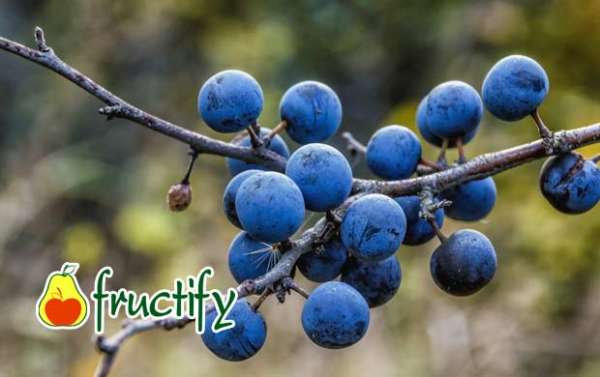

- for infectious diseases: blackthorn is a natural antiseptic, it kills harmful bacteria in the gastrointestinal tract when ingested, and when applied externally, it disinfects wounds;
- for skin diseases, injuries, burns: fruits relieve inflammation, accelerate healing;
- in case of poisoning: blackthorn helps to eliminate toxins and toxic substances from the body, reduces nausea;
- for the nervous system: has a calming effect, reduces nervousness;
- for vision: fruits increase visual acuity, protect against the development of glaucoma;
- to improve metabolism: the berry improves blood composition, increases the rate of metabolic processes in the body;
- for the health of the gallbladder: thorns promote the outflow of bile.
| Flora and fauna of the Rtishchevsky district | |
| Flora of the Rtischevsky district | |
| Mushrooms of the Rtishchevsky district | |
| Fauna of the Rtischevsky district | |
| Red Data Book of the Saratov Region | |
| Rtischevo and Rtischevsky district in themes | ||
| Symbols and awards | ||
| People of the city and district | ||
| Geography and biology | ||
| Administrative-territorial division | ||
| History of the Rtishchevsky region | ||
| Power and control | ||
| Economy | ||
| Railway | ||
| Education and Science | ||
| Health care | ||
| Communications, telecommunications and media | ||
| Culture | ||
| Rtishchevsky deanery | ||
| Sport | ||
| Layout and architecture | ||
| Armed forces | ||
How to plant thorny plums?
Thorny plum is propagated mainly by vegetative methods, by seeds - only for breeding purposes. The most popular breeding methods:
- root shoots;
- cuttings;
- vaccination.
Most appreciated are self-rooted seedlings, which are usually obtained from root shoots. Let us consider in more detail the process of planting thorny plum seedlings.
Site selection and land preparation
Planting thorny plums is preceded by the selection and preparation of the site. True, you don't have to try especially - this culture grows beautifully in any corner of the garden. Moreover, blackthorns are often used as an artificial fence, planted along the boundaries of the site. Planting thorny plums protects other trees and shrubs from the winds.
Terosplum is not demanding on soils, but it grows especially well on clay soils. The soil is prepared in late autumn, at least 1.5-2 months before planting. The earth is dug up and fertilized.
For 1 sq. m make:
- manure - 8 kg;
- superphosphate - 50 g;
- potassium salt - 30-40 g.
All fertilizers are thoroughly mixed with the dug up soil. It is advisable to test the soil for acidity. If it is less than 5.5 pH, lime is added.
How to get seedlings?
The most popular way to propagate blackthorns is by own-rooted seedlings. The easiest way to get them is from root shoots, which are harvested in spring or autumn.The healthiest and strongest plants are selected, located farther from the trunk - they have a better developed root system, and it is easier to separate them without damaging the mother plant.
Having dug out the shoots, they look at the roots. If they are developed, the process can be transplanted to a permanent place, if not, it is grown. Shoots sent for growing are cut to 20-25 cm and placed in nutrient soil. By next fall, the seedling will be ready for transplanting. This is a simple and affordable way to get seedlings, but it is not suitable for large-scale cultivation - the volumes are too small.
A more productive, but also more difficult way to get seedlings is grafting. The rootstocks are pre-grown - for example, a winter-hardy plum or felt cherry is suitable.
Planting seedlings
The optimum age for planting seedlings is 2-3 years. They are usually planted in the spring. The best time to plant is late April or early May.
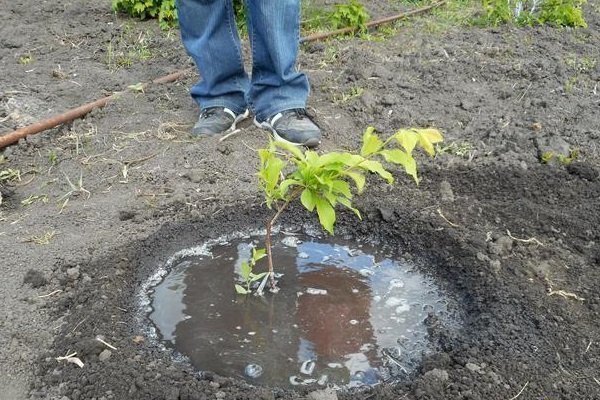

Planting order of thorny plums:
- In the prepared area, holes are dug, the width and depth of which are adjusted to the size of the roots. Standard dimensions - depth 50 cm, width - 70 cm. Between the pits, the interval is 4-4.5 m. 5 kg of humus are poured into the pits, put in a glass of ash and a handful of lime, 100 g of superphosphate and 40 g of potassium sulfate. All components are pre-mixed.
- From above, the fertilizer mixture is covered with soil, so that the hole is half full.
- Seedlings treated with a root growth stimulator are immersed in a hole, spreading the roots to the sides.
- The roots are covered with fertile soil, and carefully tamped so that 2-3 cm remain from the root collar to the ground surface.
- The trunk circle is abundantly watered and mulched.
- The crown is cut so that the height of the seedling from the soil surface does not exceed 80 cm.
So that the blackthorn does not "crawl" over the site, an artificial barrier is made for root growth - sheet metal or slate is buried a meter deep.
Miraculous decoctions
Blackthorn is a "magic" shrub that can be used to prepare medicinal decoctions used to combat many human ailments.
Decoctions prepared on the basis of thorns perfectly cleanse the blood and have anti-toxic properties. This is an excellent folk remedy for treating various skin rashes. He is also subject to pustular rashes and furunculosis.
By the way, wild thorn is a plant that contains all the necessary substances that act as a sedative in humans. Therefore, it is used to prepare healthy drinks that help with insomnia or neuralgia.
The broth also has a positive effect in the treatment of diseases of the oral cavity, for example, inflammation of the gums or throat.
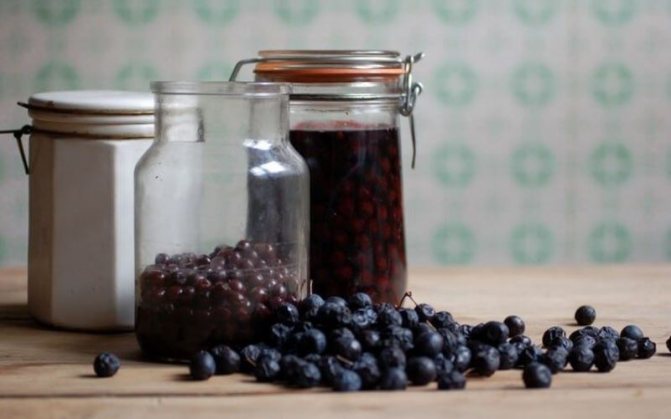

Blackthorn berries are widely used for making compotes, preserves and liqueurs.
In order to prepare a miraculous broth, it is necessary to prepare the flowers of the plant, previously dried. They need to be poured with boiled water in the amount of 0.5 liters. The mixture is put on fire and boiled for 5 minutes. The resulting broth must be filtered, and you can use it instead of tea several times a day.
The thorn bush, as already mentioned, differs from other medicinal plants in one special property - the ability to purify the blood. The bark of the plant is used for treatment. This broth has an excellent effect in the fight against various female diseases.
To prepare a decoction, you need to take a small amount of dried bark, pour water over it and put it on the stove. Boil the broth for 20 minutes. They consume it several times a day.
Teren is a berry known for its high effectiveness in colitis, dysentery and food poisoning, therefore it is used in folk medicine most of all. It is very rich in fructose and glucose. Also, blackthorn berries are saturated with a large amount of vitamins, and especially vitamins P.Cooked thorn juice has an antibacterial effect.
One of the advantages of the berry is its ability to dull a person's sudden feeling of nausea. Doctors recommend using them in small quantities for pregnant women.
Blackthorn berries are widely used for making compotes, preserves and liqueurs.
Diseases and pests
Teroslum is not very susceptible to diseases of stone fruit crops, but, like any tree, it is not immune from infection. But there are no pests that can significantly harm the blackthorn.
Diseases are stubborn and measures to combat them:
| Disease | Symptoms | How to fight? |
| Fruit rot | The disease begins with the wilting of young shoots. Further, the fruits become stained and rot. | Copper and iron vitriol processing. |
| Plum pockets | It is a fungal disease that occurs when humidity is high. The fruits become unusually large, deformed. There are no seeds inside them, and the pulp does not correspond to the varietal characteristics. | Spraying with Bordeaux liquid - first during flowering, then during the period of fruit formation. |
| Sharka | It is accompanied by the appearance of white streaks on the leaves. The pulp of the fruit is tough, inedible. On the fruits themselves, depressed circles and lines are visible. | Timely removal of pests, pruning with a disinfected tool. |
| Dwarfism | The leaves are deformed and become small. | This viral disease is very difficult to treat, so diseased trees are uprooted and burned. To prevent infection, use a clean garden tool when pruning. |
Contraindications
However, the thorny bush is not as healthy a product as experts believe. According to some, the harm of this product is negligible, however, according to the convictions of others, thorn is a plant that slows down the metabolic process in the body, which has a detrimental effect on human health and its general condition. And if you use teren on an empty stomach, then everything can end in severe diarrhea.
Leading experts are convinced that if you abuse the tincture, prepared on the basis of thorns, the body will begin a process of metabolic disorders, which leads to dehydration and gastrointestinal tract disorders.
For people suffering from stomach diseases, gastritis or ulcers, it is contraindicated to eat thorny fruits, since teren is a berry that is distinguished by its astringency and high acidity.
In some, after using this medicinal plant, manifestations of allergic reactions are possible. Such consequences can arise from the pollen of a flowering shrub.
It is important to know about some of the rules for the use of bush berries. You can eat them without seeds, only the pulp, since it is known that the bones contain poison that is unsafe for human health. Therefore, they can be preserved in canned form for no more than 12 months.
Gardeners reviews
★★★★★
Kristina P., Omsk region I bought a seedling from my hands. The seller - an amateur gardener, said that the variety is called "Super Abundant". The tree is already 6 years old. It is neat, small, a little over 2 meters high. Unlike the turn, it has almost no thorns. In the place where thorny plum grows, it is very sunny, but humid. I have no problems with the tree. The plum does not leave me without a harvest - in any weather it is full of fruits. This year we have gained 8 kg. I make jam from them, and I also tried adding them to adjika - it turns out very tasty.
★★★★★
Victor M., Chelyabinsk region For our places, thorny plum is a real find. This tree is not afraid of any frost. I planted the Pride of Siberia variety. Unlike most fruit trees, thorns do not have problems with fruiting - there is always a bucket, another for jam. True, you don't eat fresh fruits very much - it knits your mouth, but it is ideal for blanks - thorns are very good in compotes and jams.
Ternoslum is a versatile hybrid that deserves a place in any garden.This small tree, hardy and undemanding, will not only give you valuable fruits, but also decorate your site, protect fruit plantings from the wind, and serve as a wonderful hedge.
0
Harm of thorny
There are very few contraindications for thorn pulp. The berry should not be consumed in case of individual intolerance to the body. Pregnant women, young children, and the elderly should not overuse blackthorn as it can trigger allergies. The bones of thorny plums cannot be eaten, they contain toxic components that can cause poisoning of the body.
Do not eat thorns on an empty stomach, as this will cause indigestion and diarrhea.
How to keep a good harvest
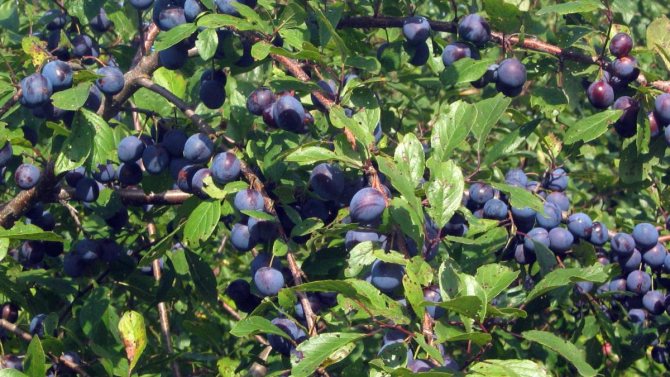

Teroslum is grown as a single-stemmed tree, which in adulthood can exceed 5 meters. The trunks of the plant are completely covered with elliptical jagged leaves and snow-white flowers, which show their petals to the world in May. A little later, fruits ripen with a rounded shape and a weight of just over ten grams. The color of the fruits, habitual to the inhabitants of the middle lane, is purple, when fully ripe it becomes almost black.
Ternoslum prefers well-lit places, slightly moist, loamy soils, loves organic matter and a pH of 6.5-7. In case of excessive drying of the soil, it is imperative to carry out evening watering, otherwise growth slows down, and good harvests can not be expected.
On a note
Ternoslum has been cultivated more than two millennia ago. Naturally, for such a long time, varieties have appeared that are very successful and beloved by many. For example. Ternosliv Solyanovsky, which is characterized by the highest winter hardiness and fruits weighing more than 20 grams. Also interesting is Ternosliv Sadovy with very large fruits, almost completely devoid of astringency. The Apricot Thorn Plum is the first successful hybrid of the Thorn plum and the hardy black apricot. Scented thorn is a new hybrid with sweet American plum. Ternoslum TSKhA gives fruits of violet-black color, sweet and very juicy.
Reproduction of thorns
Thorns can be propagated in a generative (seed) way and vegetatively: by root suckers and cuttings. It will not be possible to quickly propagate this culture in a generative way. If you need to get material for planting as quickly as possible, then vegetative methods should be chosen for this.
Propagation of thorns by seeds
In the first weeks of autumn, the seed must be removed from the fruit and cleaned of the remaining pulp. Then the bone is planted in open ground. Sowing can be done in the spring, but in this case the seeds will need preliminary stratification, for this they are placed on the refrigerator shelf for the whole winter. Some gardeners recommend immersing the seeds in honey syrup for 12 hours before sowing, the seedlings from such seeds will seem much faster. After that, they are sown, burying them into the soil by only 60–70 mm. The surface of the plot with crops must be covered. Immediately after the seedlings appear on the surface, the shelter must be removed. After the seedlings are 2 years old, you need to transplant them to a permanent place.
Propagation of thorns by cuttings
The cuttings must have at least 5 absolutely healthy buds. In springtime, cuttings should be planted for rooting in a container filled with fertile soil. The container should be transferred to a greenhouse or covered with a cap on top, which must be transparent. During the summer period, they will need to provide regular watering and feeding with a nutrient solution. By the onset of the autumn period, the cuttings will become full-fledged seedlings, in which the root system will be very well developed.
Read also: What flower is the zodiac sign of Aries
How to propagate by root shoots
Separate the suckers very carefully from the parent shrub.Then they will need to be planted in pre-made planting holes, while the distance between them should be about 100-200 cm. They need exactly the same care as the seedlings.
Nutritional and medicinal properties of the culture
The fruits of thorny plums contain up to 10% sugars, about 12% organic acids, as well as biologically active, pectin and mineral substances necessary for a full-fledged human life.
As for canning qualities, pectins, tannins, and coloring substances of a polyphenolic nature, which have P-vitamin activity and give an astringent taste to fruits, play an important role here.
The fruits themselves and their processed products are often used for medicinal and prophylactic purposes, especially for improving and normal functioning of the stomach and intestines (especially with low acidity). The fruits of thorny plums and products of their processing are contraindicated for people suffering from heartburn or increased acidity of gastric juice.
Planting a thorn in an open area
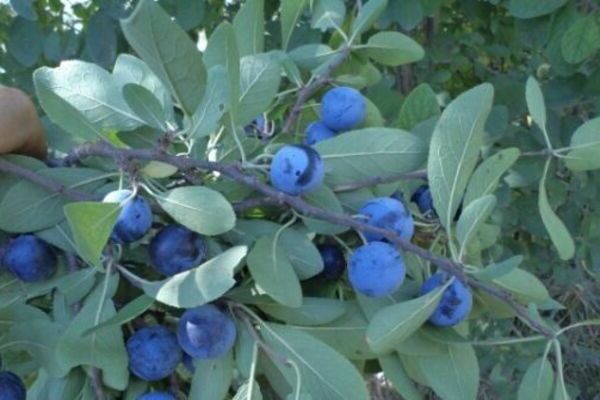

In an open area, this plant is recommended to be planted in early spring. At the same time, it is necessary to prepare the planting holes in advance, namely in the fall. During the winter, the earth will settle and settle properly.
Thorns will feel good in clay, sandy soil. Even soil with a high salt content, as well as dried soil, can be suitable for thorns. A large amount of moisture in the spring is not too dangerous for this plant. In this case, planting in too wet soil should be avoided.
It is not advisable to plant thorns also in soil with a heavy structure. In such a place, there is a risk that the shrub will be damaged by low temperatures. A well-lit place with moist soil with a lot of nutrients is best for this plant. The acidity level should ideally be neutral.
Hole for planting, it should be about sixty centimeters deep and in diameter. To prevent the thorn from growing randomly in different directions, it is recommended to lay the walls of the planting pit with slate or metal sheets.
Before planting the blackthorn, about a week before, it will not be superfluous to cover the bottom of the hole with an eggshell. It may seem that this is a very large amount, but if you collect the shells during the winter, then such an excellent fertilizer will be ready just in time for planting thorns. Prepared soil is poured out on top of such a layer.
To prepare the soil for planting thorns, it is necessary to mix the extracted soil with superphosphate (half a kilogram), compost or humus (one or two buckets), potassium dressing (sixty grams).
If the acidity level is too high, then the soil must be limed. If, in order to create a living fence from this plant, then when planting, you need to maintain a distance between plants of about fifty centimeters. If you are planting several plants at once, then the distance between them should be at least two to three meters.
After purchasing thorny seedlings, you need to produce preparation for landing... For this purpose, the rhizome of the plant needs to be kept in a nutrient solution for some time. To do this, dilute sodium humate in the amount of three to four large spoons in half a bucket of water.
In the center of the planting pit, it is necessary to put a peg made of wood, which should reach about fifty centimeters. After that, the prepared soil is marked in the hole. It is necessary to distribute it so that a small earthen hill is formed around the circumference of the installed peg. A young plant must be carefully placed on it.
In this case, the root system must be carefully straightened. The pit is then filled with the remaining nutrient soil. From time to time, you need to compact the layers of earth a little so that no voids remain.
When planting, it is necessary to ensure that the root collar of the plant remains above the ground by about thirty to forty millimeters.It is recommended to overlay the area of the tree trunk circle with a ten-centimeter roller made of soil around the circumference. After that, it is necessary to pour about twenty to thirty liters of water into this side.
When all the moisture has saturated the soil, it will not be superfluous to lay a mulching layer in the zone of the near-trunk circle. This way the plant will need to be watered less frequently. For this purpose, it is convenient to use humus. After all the above procedures, the final touch in planting a thorn is to tie the seedling to the established peg.
Disease protection
Harmful insects do not pose a threat to thorny plums, as well as most diseases affecting stone fruits. However, even such a persistent and unpretentious plant cannot be avoided. Below is a list of the most dangerous diseases for pruritus and how to deal with them.
- The wilting of fresh shoots and subsequent damage to the blackthorn fruit is the result of an infestation of the tree. fruit rot. The surface of the fruit is first covered with spots, then necrosis develops. An effective means of combating this ailment is copper or iron sulfate.
- The increased humidity of the environment causes the development of a fungal infection called pockets of plums. The main sign of infection is an unprecedented increase in blackthorn fruit in size, as well as their deformation. At the same time, their pulp loses its main characteristics inherent in a particular variety, and seeds are not formed at all. The main means of preventing and treating this fungal infection is Bordeaux mixture. It is necessary to sprinkle the affected tree twice with it - during the flowering period, and then during the ripening of the fruits.
- White streaks on the surface of the blackthorn foliage indicate a plant disease shark. As a result, the fruit pulp becomes very tough and unfit for human consumption, and concave circles and streaks form on the skin. The main way to prevent this infection is to regularly inspect thorny plums in order to detect harmful insects that carry sharki. The affected shoots must be removed in a timely manner, and the instrument used for pruning must be thoroughly disinfected.
- Reducing the size of leaves and deformation of their contours are called dwarfism. This disease is of viral origin and is rarely treatable. For this reason, the only way out is to remove the infected trees of the site along with the roots and then burn them in order to avoid the spread of the disease. The tool used in this case should be thoroughly disinfected so that during subsequent gardening work it does not provoke infection of other trees.
What is the turn
There are many varieties and hybrids of thorns that are planted in gardens. The most popular of them will be discussed below:
Cross number one. In its height, such a plant reaches about two hundred and fifty centimeters. The fruits are purple-colored, the wax bloom is quite dense. Inside, the fruits have a sweet taste with a refreshing sourness and light astringency. One fruit can weigh approximately six to seven grams.
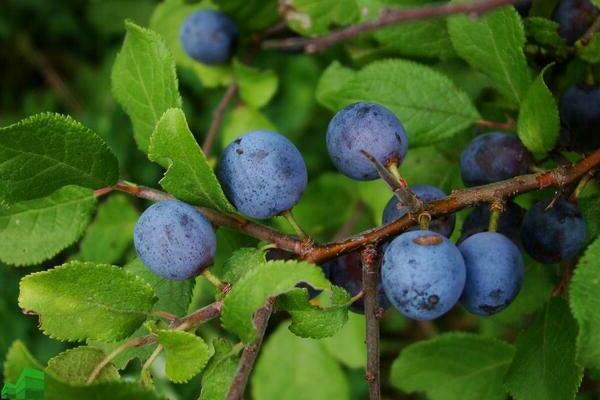

Photo of a thorn. Variety Cross No. 1
Cross number two... The fruits are purple in color and rounded. In its weight, one copy can reach about eight grams. On the palate you can feel sweetness and pleasant acidity. A slight astringency is also present.
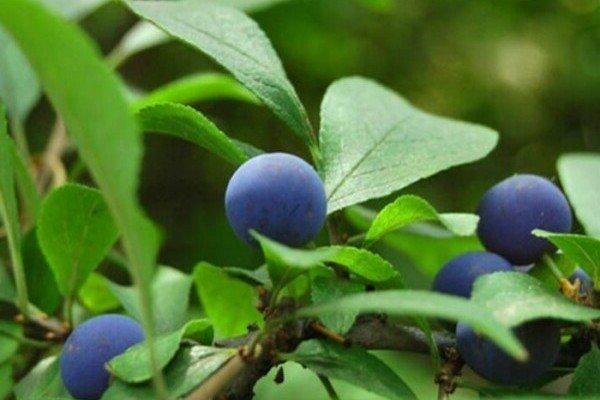

Photo of a thorn. Variety Cross No. 2
The thorn is sweet-fruited. As the name suggests, the fruits of this variety are quite sweet, with almost no astringency.
Yellow blackthorn... This is a hybrid variety of thorns. It appeared by crossing cherry plum and blackthorn. The fruits are yellow, the taste is soft and pleasant.
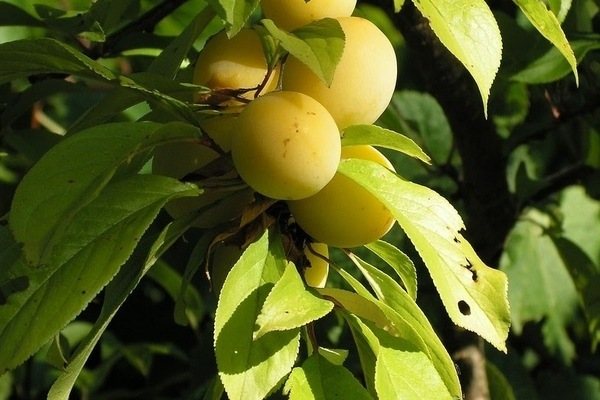

Photo of a thorn. Variety Yellow-fruited
Apricot. It is a hybrid plant obtained by crossing blackthorn and apricot. The fruits are pale in color with a pinkish tinge.Taste characteristics are quite high, apricot tones are clearly guessed.


Photo of a thorn. Apricot variety
Fragrant. This is a hybrid plant that was obtained by crossing the blackthorn and Toca plum. In its height, such a tree reaches about four meters. The fruits are colored in a purple hue, they are round in shape, slightly flattened. Fruit weight can vary from eight to ten grams. The inside of the fruit has a yellow flesh. The taste is sweet with a slight sourness. There is practically no tart component. The fruit has a very pleasant aroma with delicate apricot and strawberry tones. The seed is not large inside, the separation from the pulp is unhindered.
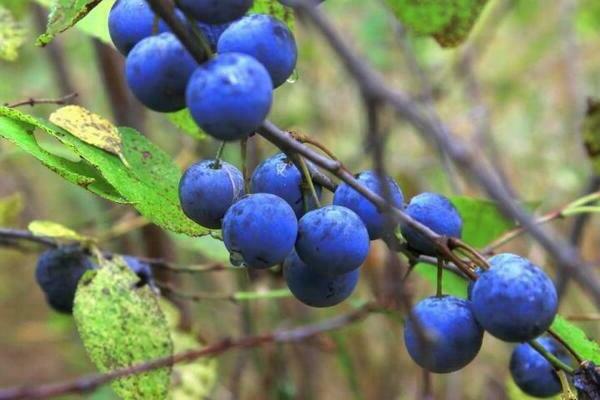

Tern Fragrant: Photo of the variety
Shropshire. This varietal thorn was obtained thanks to the labors of breeders from England. The taste is very pleasant, with a tangible sweetness. There is almost no astringency.
Cherry thorn... This plant grows about three hundred centimeters. The crown has an average density. The shape of the crown is round. The fruits are colored in a deep purple tone and have a touch of wax. One specimen weighs between five and six grams. The shape of the fruit is round. The inside of the fruit is green, with a high level of acidity and astringency.
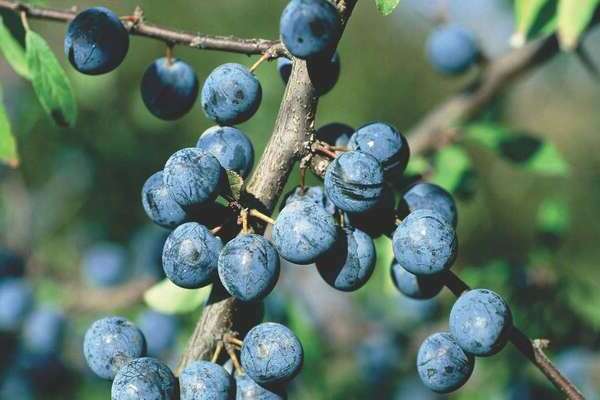

Photo of a thorn. Variety Cherry
Cherry plum... Such a tree is quite compact in size, it grows about three hundred centimeters. The fruits are rather large, round in shape. Painted in purple. The wax deposit is quite dense. One weighs approximately eight to nine grams. The inside of the fruit has a green flesh. The taste is sweet with pronounced sourness and light astringency.
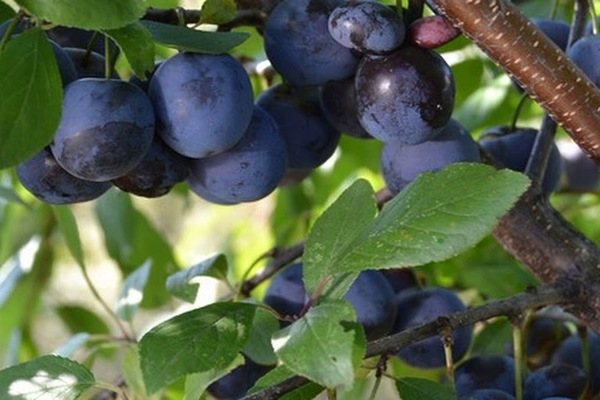

Photo of a thorn. Alychovy variety
Prunes. This is a hybrid variety that was obtained by crossing cherry plum with thorns. Fruit color may vary. There are fruits of yellowish, reddish and blue tones.
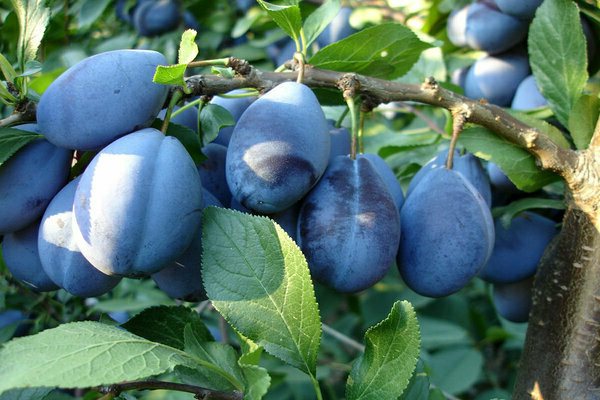

Blackthorn Prunes, photo
Garden number two... Such a bush grows in height by about two meters. The fruits are in the shape of a ball, painted in almost black or very dark bluish tone. There is a gray waxy bloom. The fruits are delicious.
About pests and diseases of blackthorn
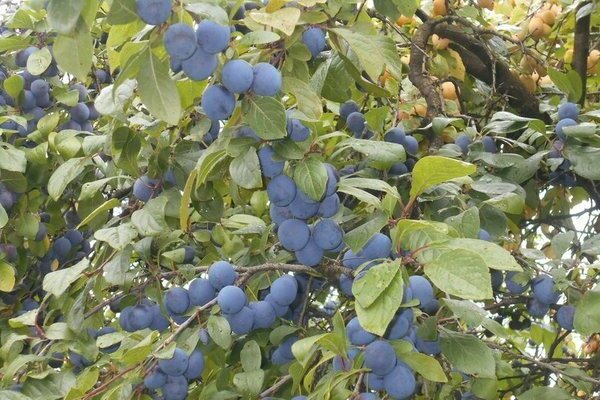

This culture has a very strong immunity against various diseases and harmful insects.
Occasionally, a thorn can be affected by such an ailment as gray rot... This disease is fungal in origin and is caused by a fungus called monilia. This fungus can enter through the flowering pistil of the plant. This disease first of all affects the youngest shoots of blackthorns. After a certain period of time, the leaf plates, as well as the shoots themselves, turn dark brownish in color.
Rot spreads from the top of the plant to the bottom. After the leaf fall, new green leaves are formed again, and at the end of summer it becomes yellow and falls off. At the same time, the number of fruits is sharply reduced.
To solve this problem caused by a fungal disease, it is necessary to treat the plant with a fungicide. In the early days of spring, you need to spray the thorns with Horus. For this, a solution is prepared, observing all the proportions indicated in the instructions. This is a tool that can be used for this purpose in case of frost.
When the weather is warm, you can treat the plant with Bordeaux mixture, Gamair, copper sulfate or Rovral. Before preparing such a solution, read the instructions for using a particular product.
As for harmful insects, the most dangerous is aphid. This insect feeds on plant sap found in stems and foliage. First of all, young shoots, as well as leaves, are affected. Because of this, the appearance of a yellow tint can be detected, as well as changes in shapes and textures.
Aphids multiply very quickly, so the harm that a whole horde of insects can do can become irreparable.In addition, aphids are the main carrier of various diseases of viral origin, and they, as a rule, cannot be treated.
To solve the problem with aphids, you need to use a drug - acaricide. Plants can be sprayed with Aktellik, Aktara or other similar products. So that the problem with aphids does not arise on your thorn plantings again, you need to process the plants more than once.
Varieties of garden prickly plum
Ornamental varieties used as green space have a spectacular appearance. Breeders have bred several varieties that, in addition to their aesthetic parameters, have many other advantages.
Terry plum is distinguished by its rapid flowering. The flowering period is quite long, which makes it suitable for decorative purposes.
The purple thorn has unusual foliage - it has dark purple leaves that turn green closer to autumn. The flowers are white-pink in color.
Red-leaved prickly plum has bright red leaves that change their color to green. This variety is resistant to frost and is used almost everywhere in our country.
Composition and nutritional value
Ternosplum refers to low-calorie foods. In 100 gr. fresh and ripe fruit contains no more than 54 calories. The same amount of the product contains:
- proteins - 1, 5 gr.;
- carbohydrates - 9, 4 gr.;
- fats - 0, 3 gr.
In addition, the structural composition of the berry includes:
- pectins;
- cellulose;
- glucose;
- fructose;
- vitamin E;
- Apple acid;
- tannins.
Thorn is allowed to be included in food for people diagnosed with diabetes. The berry is included in the list of foods with a low glycemic index (22 units).
Selection of seedlings for planting
It is advisable to purchase planting material in specialized stores or from friends who breed the blackthorn. You can independently dig root shoots from wild-growing shrubs. The main thing is that its roots are developed and healthy, and there are no signs of diseases or defects on the bark. It is better to plant several seedlings in order to select the bush with the best harvest later.
Learn how to make plums blossom and bear fruit.
It is better to purchase or harvest planting material in the spring in order to immediately plant it in the soil, and not store it in a prikop. It is advisable to give preference to two-year-old seedlings.
Cooking applications
Blackthorn fruits are widely used for making delicious jams, preserves, liqueurs and other dishes. Alternatively, they can be soaked, as is done with apples or cabbage.
Pouring
For lovers of strong alcohol, a simplified preparation method is recommended:
- 4 kg. put seedless berries in a jar, add 4 kg. sugar and 200 ml. water;
- tie with gauze and put in the sun;
- after the start of fermentation, a glove is put on the neck, piercing 1 finger;
- move the jar to a warm place and wait for the glove to deflate;
- filter the filling through cheesecloth;
- keep in a cool place (basement) for 1 month.
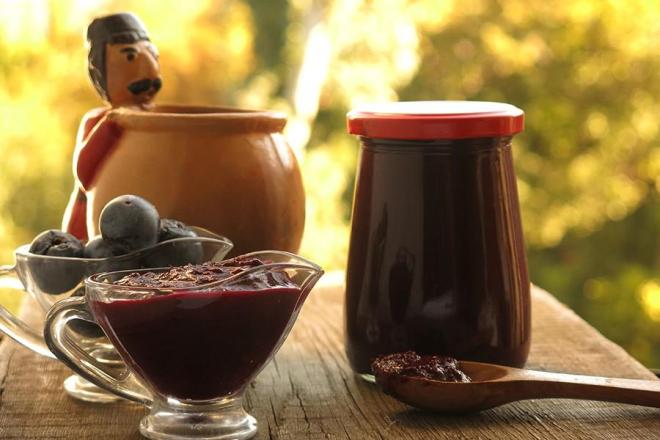

small amounts of thorn liqueur will have a calming effect on the nervous system and strengthen the immune system
Blackthorn jam, jam and jelly
Various jams and thorn preserves are very popular:
- The jam is made from 1 kg. seedless berries. First you need to boil sugar syrup (1.5 kg of sugar and 2-3 glasses of water), then add berries to the boiling solution. Bring to a boil and set aside to cool. Then a second procedure is done: cook for 2-3 minutes and set aside. For 3 times, the mass is brought to readiness over low heat, stirring and skimming. Ready jam is poured into sterilized jars and rolled up.
- Thorn juice is prepared in a juicer in a proportion of 1 kg. berries 100 g of sugar. The finished drink is poured into jars, sterilized and closed. After cooling, they are removed to a dark place.
- Jam is made from washed fruits: put them in a saucepan, add water and put overnight. In the morning, drain the liquid, add 250 g of white wine and 250 g.water for every 1 kg. berries. Cook the jam, stirring constantly, until soft. Then cool and grind until puree through a strainer. Add 1 glass of wine and 375 g of sugar to the resulting mass, cook over low heat until viscosity, pour into jars and roll up.
- For jelly, you need 1 liter. thorn juice and 1 kg. Sahara. The juice is poured into an enamel container, brought to a boil, adding sugar in portions, and the mass is boiled until tender. Pour jelly into jars and close hermetically.
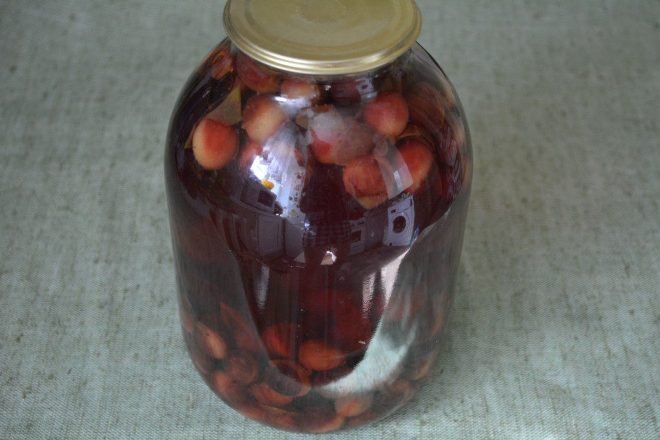

with sloe berries makes a delicious compote
Tea and kvass from sloe
Blackthorn tea not only tastes good, but is also used for medicinal purposes for digestive disorders (constipation, bloating, nausea). It is simple to prepare: pour 25 g of dry leaves and flowers with 1 glass of boiling water, leave for 1 hour. You can drink it like tea, and for medicinal purposes - ¾ glass three times a day before meals.
To prepare kvass, you will need 500 g of berries, 3-4 liters of water, ½ glass of honey and 15-20 g of yeast:
- Rinse the fruits, remove the seeds, grind until puree;
- add 3-4 liters. water and boil for 40 minutes;
- filter the broth, add yeast and honey;
- put for fermentation for 10-12 hours in the room;
- pour the ready-made kvass into bottles, store in the refrigerator.
Pouring, wine and moonshine from thorns
There are several recipes for making delicious thorn liqueurs and alcoholic beverages. Pouring of thorns and grapes is prepared with the addition of red grapes (Isabella, Alpha, etc.). 2 kg. rub the berries with a cloth, sort out, 2 kg. mash the grapes with a rolling pin (do not remove or wash the seeds). From 1 p. water and 1 kg. sugar, prepare sweet syrup, cool and add together with berries in a container with a wide neck. Cover the jar with gauze and place in a warm place to ferment.
After 2-3 days, when the wort has fermented, pour the mass into a bottle to ¾ level, put a water seal and wait 2 weeks until the mass ferments. Drain the resulting wort and put it in another jar cool, and add 5 liters to the cake. vodka or alcohol, leave for 14-15 days. Then drain the alcoholic infusion, squeezing out the remaining berries, filter. Drain the previously obtained liqueur and combine with the tincture, then leave for infusion for another 4-5 weeks. The liqueur should be tasted periodically, adding sugar as desired.
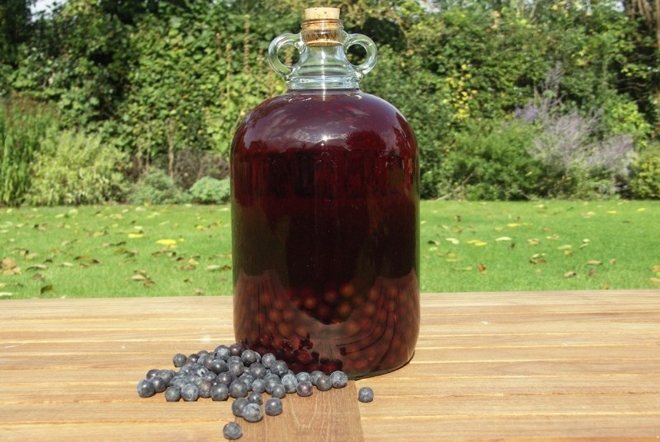

wine with blackthorn berries has great nutritional and medicinal value
Moonshine, popularly called "thorns", is prepared at home and is a traditional drink.
The process of making moonshine with yeast:
- 5 kg. grind small berries into gruel, separating the seeds;
- top up with 1 liter. water and heat up to + 70 ° С, cook for 7 minutes;
- Pour the juice that appears, and add another 1 liter to the sediment. water and 300 g of sugar, heat and drain;
- Mix everything in a fermentation vessel and add 3 liters. water;
- cool the wort to + 25 ... + 29 ° С, add 40 g of dry or 200 g of pressed yeast;
- put the mass for fermentation for 3 months;
- pour the resulting mash, leaving a sediment, distill 2 times;
- dilute the alcoholic product to 40% strength and bottle.
Blackthorn sauce
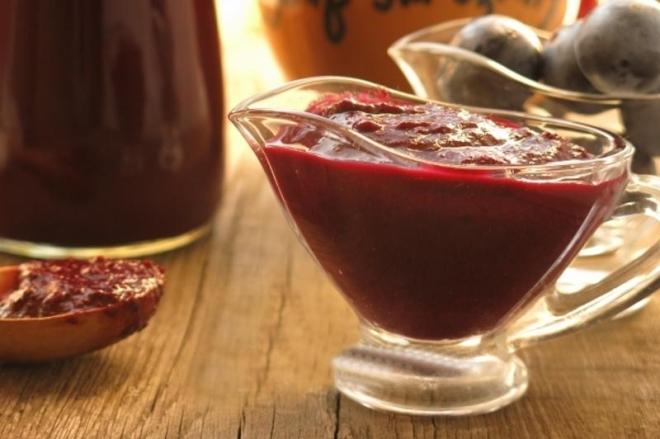

thorn sauce is a tasty and healthy addition to any dish
One of the variants of the famous Georgian tkemali sauce is made from thorn berries:
- wash and peel 3 kg. thorns, put in a saucepan and cover with sugar (2-3 tbsp. l.), wait until the berries let juice;
- chop 1-2 pcs. hot red pepper and 10-12 cloves of garlic;
- put the pan on the fire and add 1-2 glasses of water, cook for 30-40 minutes until the berry mass softens;
- rub the mass through a colander, removing the skin;
- put to cook, adding 2-3 tbsp. l. salt, 2 tsp. vinegar and garlic-pepper mixture;
- boil the mass with constant stirring for 1 hour;
- pour the prepared sauce into the jars, close and turn over.
Ternoslum: description of the variety and its characteristics
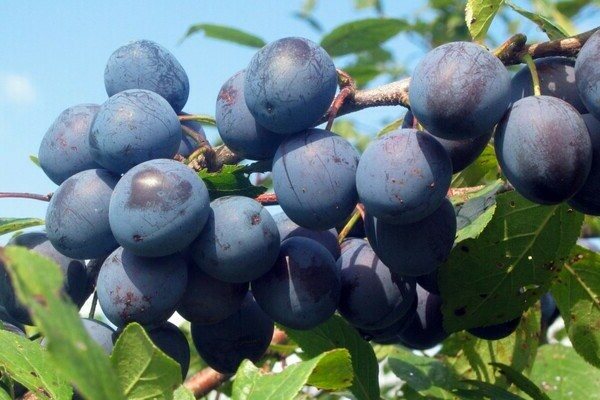

Ternoslum has a number of similarities with each of its parents.And if the fruits bring it closer to the home plum, then the appearance of the tree was largely inherited from the wild-growing shrub. The blackthorn is sometimes confused with the blackthorn, although it has its own distinctive features. The similarities and differences between the two plants will be discussed below.
Appearance
Ternosplum is a shrub plant: its branching shoots can grow up to 4 m in height. The foliage consists of small (only about 5 cm long) leaves that are elliptical and jagged. The flowering period of the blackthorn begins quite early. The flowers are snow-white in color and about 3 cm in diameter, they bloom before the leaves appear completely. Located singly, they open up in large numbers, forming a lush white crown of the bushes.
During the fruiting period, spherical fruits are formed, painted in dark blue or black and covered with a bloom resembling wax. The average weight of the fruit is about 15 g, the average diameter is about 4 cm. Under the thin peel there is a dense, sweet-sour pulp with tart notes that hides a bone. The astringency of the fruits depends on how long they are on the branches: the longer - the sweeter they are, the less bitter notes in their taste.
Features of culture
Ternoslum possesses a number of distinctive features obtained from its parents and constituting a combination of properties characteristic of this hybrid.
First of all, thorny plum is famous for its fertility. The fruiting period occurs in late summer and early autumn, when numerous fruits are formed on the branches. They are firmly attached to the branches and are able to survive on them until the winter cold.
Another advantage of the blackthorn is its resistance to frost - one of the highest among fruit plants. Ternoslum is able to withstand temperatures as low as -40 degrees. In case of frostbite of the plant root system, recovery occurs very quickly.
The blackthorn successfully tolerates dry periods: the surface of its bark is not damaged by sunlight. In general, thorny plum is very hardy and takes root safely even in regions with unfavorable climatic conditions, as well as on rather poor soils.
Diseases common among fruit crops practically do not pose a danger to thorns, which have high immunity. It also successfully resists attacks by harmful insects.
Thus, the thorny plum is distinguished by its ability to cope with any difficulties associated with the conditions of its environment. The only danger to it is represented by swampy places, as well as salty soils, on which this culture does not take root. In all other cases, it gives abundant growth, which quickly captures the nearby space. For this reason, it is categorically not recommended to place valuable plants next to the thorny one.
Thorns and thorns - what is the difference?
Ternoslum has many similarities with its parents - thorns and home plums. The healthy fruits of wild thorns cannot boast of a pleasant taste, so crossing with homemade plums gave the resulting fruits of the hybrid culture a pleasant sweetness. At the same time, they retained most of the beneficial properties of thorn fruits.
The fruits of the blackthorn, as a rule, are much larger than the fruits of the blackthorn, they have a juicy sweet pulp that has lost almost all the astringency of the latter. The shoots of thorny plum do not have thorns characteristic of thorns that make harvesting difficult, which increases the popularity of this hybrid crop among gardeners.
In terms of their chemical composition, the fruits of thorns and thorns are almost identical and differ mainly in the concentration of sugar in the pulp. If for the blackthorn it is from 5% to 6%, then for the thorny one this indicator fluctuates between 12% and 14%.
Territory growing area
In the wild, thorny plum grows in the southwestern part of Asia.The homeland of this hybrid plant is Syria, where it received the name "Damascus plum". From Syria, the ternovka was transported to the British Isles, from where it penetrated into Europe.
Due to its resistance to severe frost and drought, it has successfully taken root in the regions most unsuitable for horticulture. Today, this hybrid culture has become widespread and is grown in the gardens of Europe, North America, Western and South Asia, and northern Africa.
Varieties of thorny plums
Thorny plum is often confused with blackthorn; many take it for a wild plant. In fact, this hybrid has long been used in cultivated fruit growing and has many varieties. The main difference between the best varieties of ternos is the highest indicators of cold resistance and productivity.
Consider the main varieties of this fruit plant:
In this article, I, as an experienced gardener, will tell you about growing thorny plums. I will designate the beneficial properties of blackthorn fruits, as well as who is strictly forbidden to eat hardy.
Agrotechnics of thorny plums
The preferred time for planting thorny plums (like all stone fruit crops) is spring, usually the end of April, because during this period the soil is most suitable for planting - it is rich in moisture and is already sufficiently warmed up.
The planting scheme depends on the variety - the strength of its growth, the diameter of the crown, and can be either 5 x 3 or 3.5 x 4.5 and even 3 x 3 m. , the dimensions of which are 60-70 cm in width and 40-50 cm in depth, but can vary depending on the degree of development of the root system, that is, be more or less. It is advisable to add fertilizers to the planting hole, which will help the plant to quickly "get used to" in a new place. Usually humus, superphosphate and sodium sulfate are added, and, of course, the upper fertile layer of the earth in equal proportions in a total amount equal to a bucket. After planting, the root collar of the seedling should be 2-3 cm above the soil level.
Watering... Of course, the planted plants need to be watered, but the main thing here is not to overdo it (no more than 2 buckets per plant), but mulch the soil around with a layer of humus 2 cm in order to save moisture and slow down the growth of weeds.
Care... As for care, in the first few years after planting, it comes down to weeding and watering, then, as the plants mature, fertilizers, both mineral and organic, need to be applied. It is imperative to ensure that the soil of the near-stem circles is constantly loose and free of weeds.
Top dressing... Mineral fertilizers are best applied as follows - in the spring nitroammofosk in the amount of a tablespoon under each tree, can be dissolved in water, at the end of flowering - a teaspoon of potassium sulfate and superphosphate (or a tablespoon of potassium sulfate in a bucket of water), after fruiting - by 250 g of wood ash.
Pruning... A few words should be said about formations... This process is often ignored by hobby gardeners, but it is also important. Plants of thorny plums are formed either according to a sparse-tiered system, or give the plant a bush-like shape. Subsequently, in order to preserve the shape given to the plants, they carry out sanitary and rejuvenating pruning, and also remove excess shoots.
With the aging of the bushes, they are rejuvenated due to strong coppice shoots, and they do the same when plants are damaged by severe frosts.
Diseases and pests... Of the diseases, the most dangerous is the perforated spot, and of the pests, the ringed silkworm; fight them in the usual ways - with approved fungicides and insecticides.
Features of the thorn bush
The thorn can be a shrub or a short tree. The height of the shrub can be up to 3.5–4.5 meters, while the tree grows only up to 8 meters.Thanks to the abundant root growth, such a shrub can grow quite actively in breadth, while difficult and very thorny dense thickets are formed. The taproot is buried in the ground by 100 centimeters, while the root system is branched, it grows strongly and can protrude quite far beyond the projection of the crown. There are a large number of thorns on the surface of the branches. Elliptical obovate leaf plates reach 50 mm in length and have a serrated edge. Before the foliage opens on the bush in April or May, numerous single small five-petalled white flowers bloom. The fruit is outwardly very similar to the plum, this rounded odnokostyanka has a tart-sour taste, it reaches about 1.2 cm in diameter. The fruit is colored dark blue, and on its surface there is a waxy bloom of a bluish color.
Fruiting begins at two or three years of age. Thorn is an excellent honey plant, and it is also resistant to drought and frost. Even a person who is a beginner in gardening can plant and grow such a shrub. Blackthorns are used to create hedges, to reinforce sliding slopes, and as a rootstock for plums and apricots. To decorate your garden plot, you should choose decorative varieties of such a plant, namely: terry, red-leaved and purple thorns.
Read also: Folk remedies for pain in the joints of the hands
Fruit selection criteria
The ripe fruits of the thorn plum are of medium size. The diameter of a ripe fruit does not exceed 14 cm. The skin color of thorns is deep blue. The difference between thorns and plums is the presence of a waxy gray bloom on the skin.
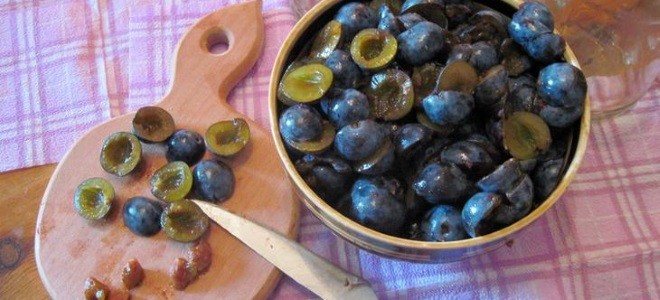

The most delicious and healthy berries are those that hung on the tree before the first frost. This means that picking the fruit immediately after ripening is not recommended. It is best if the berry hangs on the tree and is filled with useful and nutritious qualities.
For cooking, as well as for eating, it is necessary to choose fruits with elastic skin. There should be no dents, cracks, or traces of rot on it.
Hedge of thorns
A living fence of thorns is created according to the general principle, however, it is necessary to take into account the characteristics of the variety.
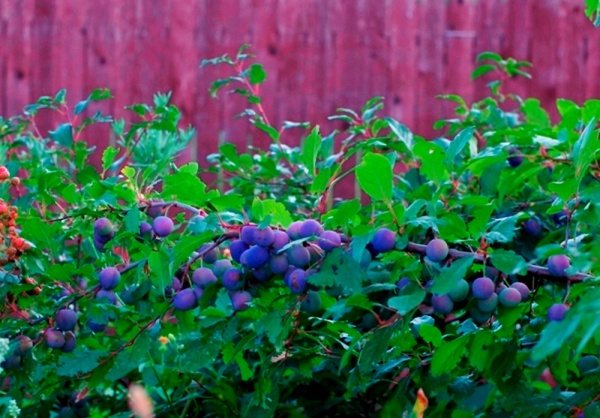

Stage number 1. Preparation. Marking is performed on the selected area. After that, pits with a depth of 60-80 cm are prepared. The width depends on the size of the rhizome, the main condition is that there are no root creases. Pits are dug at a distance of 1.5 meters from each other.
Stage 2. Fertilization. When planting, a prerequisite is fertilizer. A mixture of compost and manure is placed in the pit, as well as calcium (this can be a mineral calcium-containing fertilizer or ground eggshell). Plants are watered abundantly in two stages: first, water is poured into an open hole under the rhizome and then on top of the compacted soil surface.
Important! Each seedling must be secured with a peg. This measure allows you to shape the crown and position of the shrub.
Advice! Watering is carried out regularly in the first month after disembarkation and on particularly hot summer days.
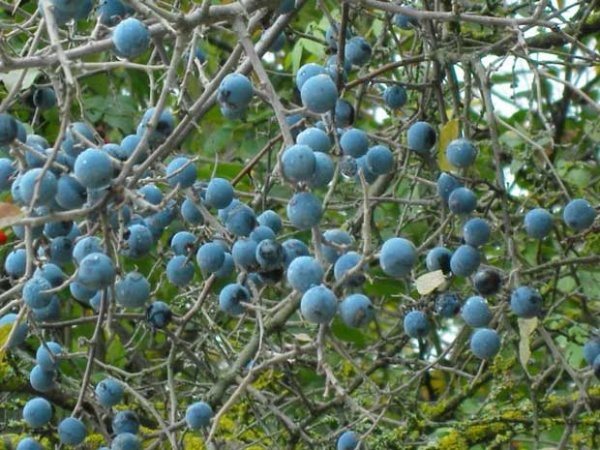

Stage number 3. Care. Blackthorn hedges require regular trimming and root thinning throughout their life. This is due to the fact that the turn grows rapidly and gives rise to growth. Within two years, you will have a solid green wall. In addition, every autumn the thorns are fertilized.
Therapeutic use
The healing properties of blackthorn are used in the treatment of diseases of the respiratory and digestive systems, have a beneficial effect on the blood and the state of the epidermis.
Infusion
Tincture of thorns is used in the treatment of chronic diseases of the kidneys, liver, and urinary organs. It stimulates the metabolism and helps get rid of skin rashes caused by infections or allergies.
For cooking 2 tbsp. l. leaves and flowers should be poured with 250 ml of hot water, put to infuse overnight, filtered.Drink ¼ glass three times a day.
Decoction
There are 2 recipes that use blackthorn roots or fruits:
- A decoction of thorns from the roots has an antipyretic effect, helps to speed up recovery from colds, is used for douching and the treatment of female inflammatory diseases. It is prepared from dried roots (5 g), which must be poured with boiling water (250 ml) and boiled for 30 minutes. After that, the broth should be cooled and filtered for 3 hours. Drink ¼ glass three times a day.
- A decoction of thorn berries is used in the treatment of inflammatory diseases of the respiratory, urinary and digestive organs (pancreatitis, bronchitis, colitis, cystitis, rheumatism, gout). For its preparation 2 tbsp. l. dried berries must be poured into 1 liter. boiling water, simmer over low heat for 10 minutes, drain. Drink ½ glass 4 times a day before meals.
Tincture
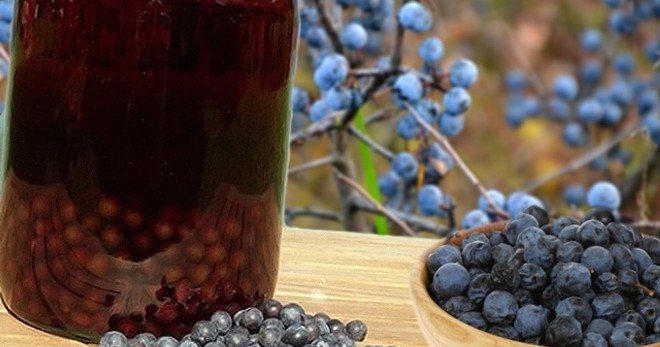

a glass of alcoholic tincture at night will enrich with vitamins, help relieve fatigue and sleep soundly
For its preparation, fresh fruits are taken, which must be carefully washed so as not to wash off the wax coating. The thorn tincture is prepared as follows:
- 1 kg. pour ripe seedless berries into a glass jar;
- add 300 g of sugar;
- put gauze on the neck and put on a sunny place for 3 days;
- after fermentation, pour in vodka or alcohol (pre-dilute to 40% vol.), mix;
- close the lid and leave for 14 days in the room, shaking the container daily for the first 7 days;
- filter the finished drink through cheesecloth;
- drink 30 ml. three times a day.
Ternoslum - the predecessor of the plum
Ternos, also known by gardeners as thorns, prickly plums or goat berries, are the predecessors of the common plum. This fruit crop is widespread almost throughout the territory of Russia. Not all gardeners are equally respectful of the thorn fruit. For example, in the southern regions they are more often engaged in the cultivation of honey plums or prunes, but in Siberia the thorny plum is recognized as beauty and pride.
Ternoslum is endowed with useful properties. Compotes, preserves, jams are prepared from the fruits of thorns. The fruit is also used for medicinal purposes, folk healers use the product to prepare remedies for a variety of diseases.
If earlier the blackthorn was considered more of a wild crop, nowadays thorny is actively grown in gardens. Caring for a fruit tree is not difficult, but in order to get a rich and healthy harvest, it is necessary to take into account some features.
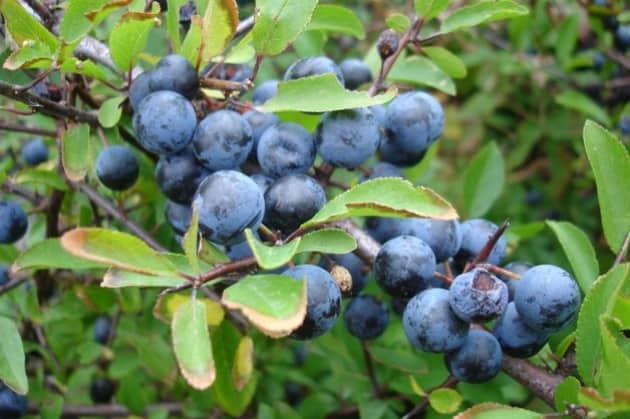

Blackthorn is a small, thorny shrub. An adult tree reaches no more than 3 m in height. In young plants, the branches are velvety, in adults, elastic and hard. The bark of the trunk of a fruit tree is colored dark red, brown or brown. The culture has a massive root system.
In the spring, the flowers on the branches of the thorn appear before the leaves. The inflorescences are solitary, their diameter is not more than 2 cm, the color is from white to pale pink. The flowering period of the blackthorn falls on the end of April - beginning of May. At this moment, the tree is completely covered with pale pink flowers and is the pride and decoration of the garden.
After flowering, leaves begin to appear on the tree. Young plants have a delicate fluff on the surface of the leaves, while in adult trees there is no fluff on the leaves.
In late August - early or mid-September, thorns begin to bear fruit. The first fruiting of blackthorns occurs in the 3rd year of the tree's life. An adult plant bears fruit regularly and has many fruits. As a rule, up to 15 kg is removed from one shrub. ripe, aromatic and healthy fruits.

